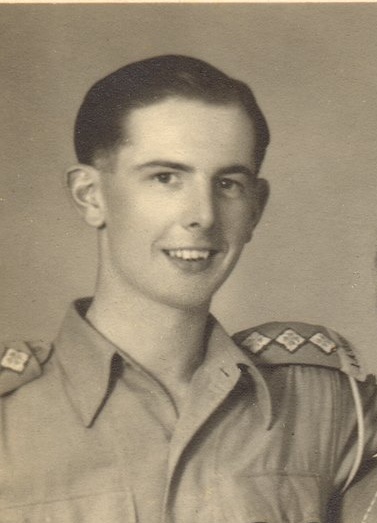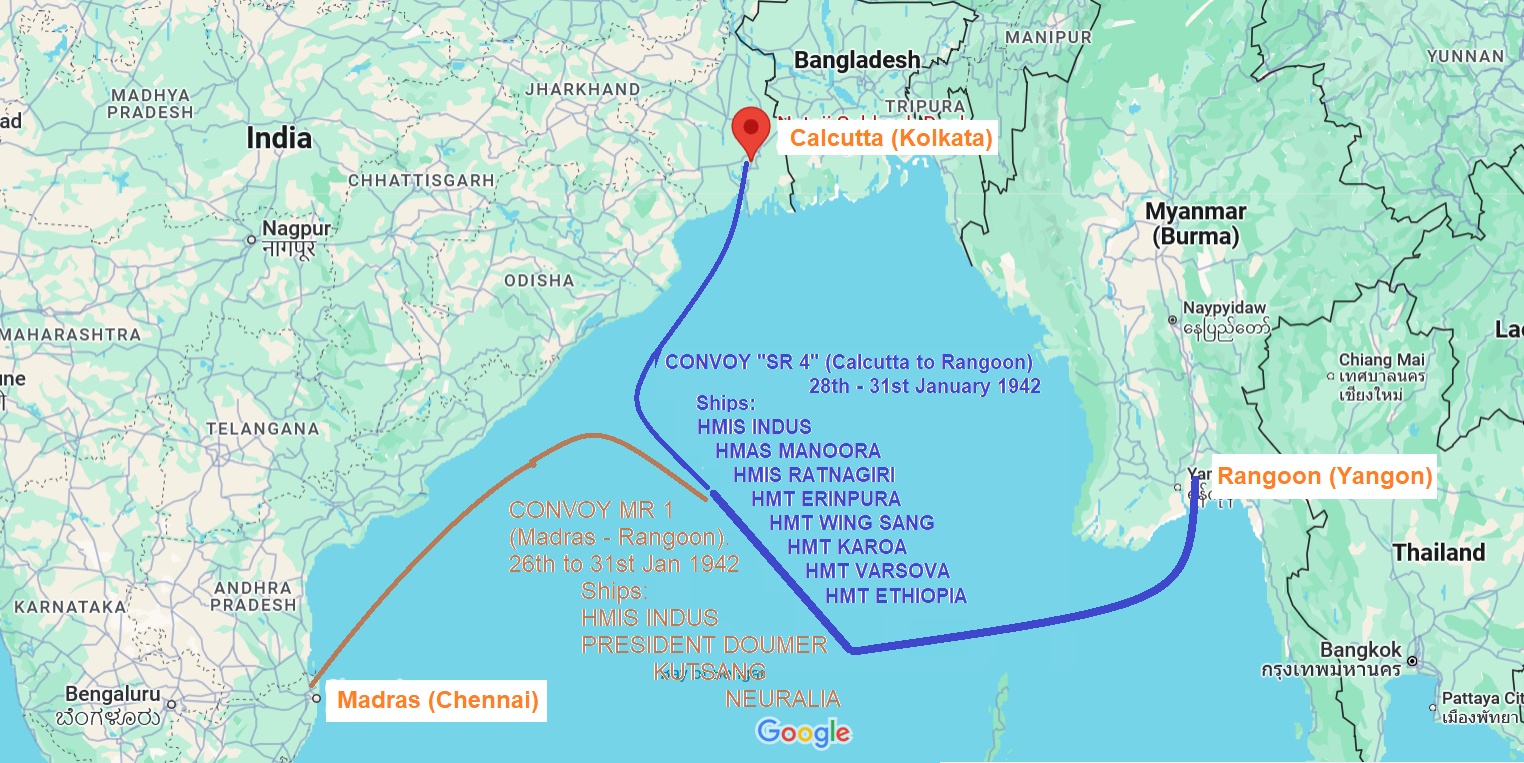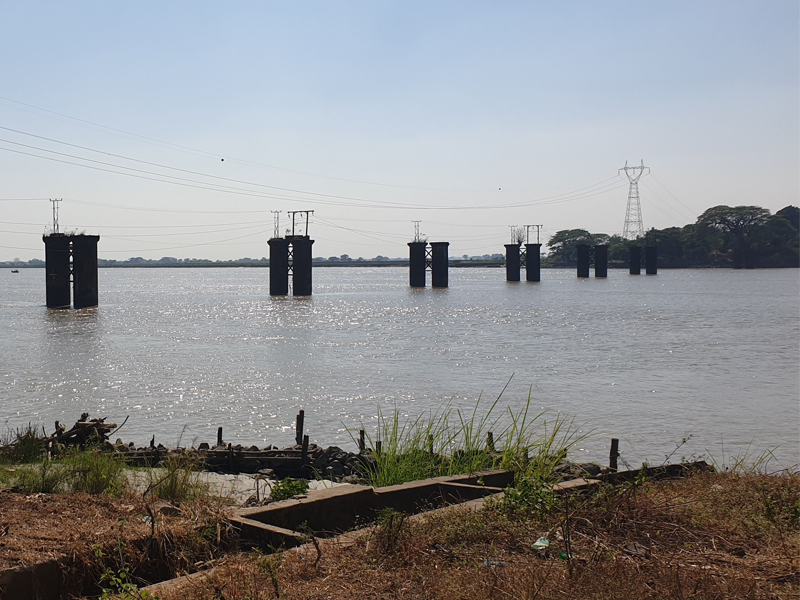WWII - Burma
19 Sep 1941 - 18 Mar 1942
by Capt. Frank Gould Smith (28 Sep 1920 - 12 Mar 2008)
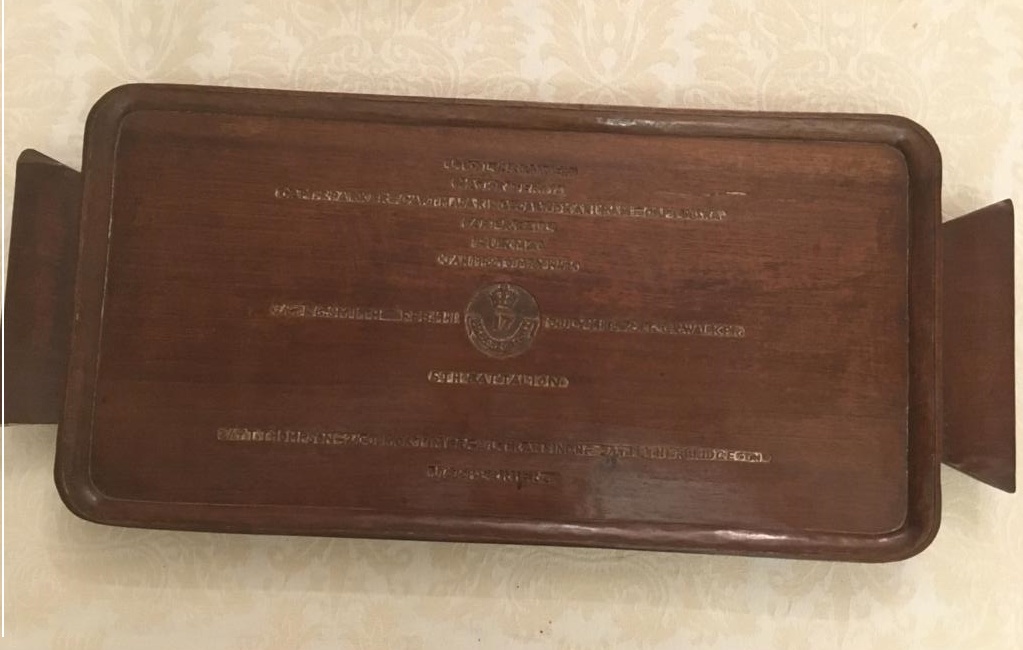
The 5/17th Dogra - Engraved Wood Tray.
Foreword: by Ian Smith
Transcribing these pages from the WWII memoirs of our dear Father has been both a rewarding and poignant experience. In life, he never spoke of these things.
I hope he would approve this publication, in honour of all those brave souls he has mentioned by name, and in memory of all the battalions, British and Indian soldiers, who fought and died for our freedom.
His words in cursive print distinguishes them from my added chapter headings, notes and references.
Clarifying timeline and geography together with pictures and a video has given me a better understanding and a fleeting glimpse into that catastrophic withdrawal, and a country under sudden attack.
All pictures can be clicked to open in a separate tab. Many have "ref." and "image source:" links below.
Certain words (in blue) can be hovered over with a mouse (/or long touch) for an explanatory popup, and if a blue word is underlined, it can also be clicked/touched for more detail.
Version...
INDEX
Pg.
Chapter.
1
Training for Desert Warfare - 19 Sep 1941.
2
Training for Jungle Warfare - circa. 3 Jan 1942.
3
Officers and Men of the 5/17th Dogra - 19 Jan 1942.
5
"...no doubts as to our destination."
6
Calcutta quay-side - circa. 21 Jan 1942.
7
Convoy SR 4 (Calcutta to Rangoon) 28 Jan 1942 to 31 Jan 1942.
9
Rangoon - 31 January 1942.
12
Rangoon to Hnin Pale - 1 February 1942.
14
Back to Rangoon with surplus baggage - 3 February 1942.
18
Rangoon to Duyinzeik - 6 February 1942.
20
Duyinzeik - 13 February 1942.
21
Withdrawal from Thaton and Duyinzeik - 17 February 1942.
23
Gruelling cross country march, Duyinzeik to Bilin - circa. 18 February 1942.
26
Battle of Bilin River - rearguard action by 5/17th Dogras - 19 February 1942.
29
Battle of Bilin River - west bank - circa. 19 February 1942.
30
Transfer to Div. H.Q. at Kyaikto - 20 February 1942.
31
Mokpalin - 21 February 1942.
32
Relocating 30 miles west of the Sittang - 21 February 1942.
34
Relocating to Pegu - 24 February 1942.
36
5/17th Dogras - circa. 25 February 1942.
38
Relocating to Hlegu - circa. 26 February 1942.
39
Malaria.
42
The Indian Army Lists - F. G. Smith ranks and appointments.
MAP
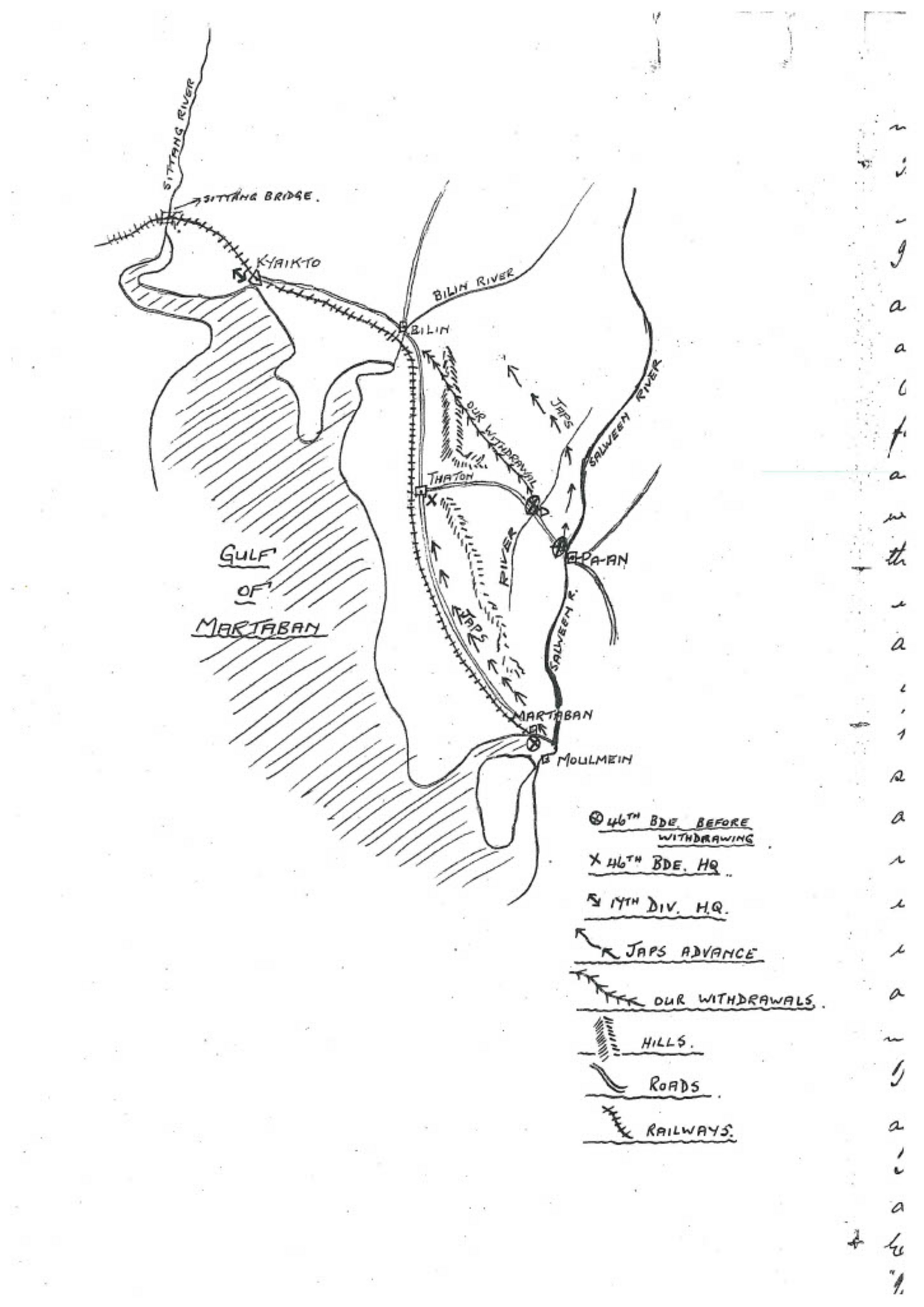
Withdrawal from Martaban to Sittang Bridge - incl. the Duyinzeik to Bilin march across country by 1/7 Gurkhas and 5/17 Dogras on 18 Feb 1942.
by Capt. F. G. Smith.
1
Training for Desert Warfare - 19 Sep 1941.
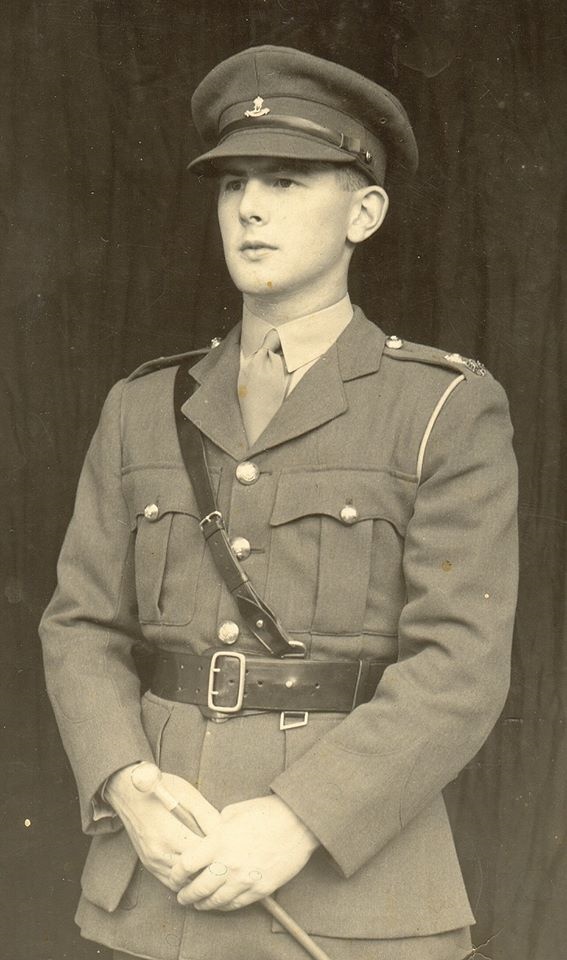
2nd Lieut. F G Smith commissioned 10 Sept. 1941. - ref.
click here
To start off with, I think it only just, to our
A Brigade consists of a few battalions, anywhere from 3,000 to 5,000 soldiers, usually commanded by a Colonel.
Brigade,
♪♪ in fact our complete
An infantry division combines infantry with support units like artillery, engineers, and medical personnel. It's a self-contained formation capable of operating independently in the field, usually commanded by a Major General.
Division
“17th”, to make it perfectly clear as to what type of country we were training in while in India, and what particular type of training we went through with great pains. Also, how we were given the order to change all training only a few weeks before going straight into a battle area.
Starting from when I joined my
5/17th Dogra Regiment, on the 19th September 1941. The Bn was then in “Ahmednagar” roughly 52 miles east of Poona,
and later on in “Kedagaon” 30 miles east of Poona where we were in camp.
I had just spent ten days joining leave, after six months training at “The Cadet College”, Bangalore, now an officers training school.
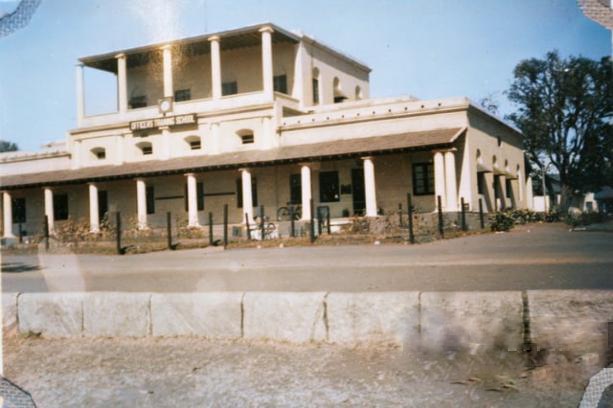
Officers Training School, Bangalore. (pic.1946)
You can imagine how thrilled I was when I was told the Bn was preparing to go overseas, which my
C.O. "Commanding Officer."
C.O.
at that time Lt. Col H. R. Power, assured me would not be long. Very soon indeed.
I fell into the daily routine, if you could have called it routine, of the Bn, and was taking part in all kinds of advanced training, similar to what we might expect on Active service. Act Service, with regard to our training meant to us, The Middle East, and this brings me to the type of country in which we trained.
If anyone who reads this, has ever been in, or near to ‘Ahmednagar’, they will realise what the country is like, but for the benefit of those who have not, I should like to say a few words.
2
The country in this part of India, is what I, by now describe as, “a wide open plain” with several hills close to Ahmednagar itself, and an occasional clump of typical Indian fir trees. Apart from this, there is what one may say, as the '
Possibly, “Raven” - Edgar Allan Poe, “Quoth the Raven, Nevermore.”
Ravin
,' “nothing more”. With an idea of the layout of the country and to that of our training brings me to my next paragraph.
Training for Jungle Warfare - circa. 3 Jan 1942.
Something like two and a half weeks, before being sent overseas, our C.O. called all the officers into his office, and informed us with his usual cool and unflinching manner that, we had to change our training to a considerable extent. In fact, he told us we had to train for Jungle-Warfare. Time at our disposal, did not seem to worry us, but the real question and problem, remembering my description of the country, was “How’, and ‘Where’, were we to carry out our new order.?
Our C.O. understood every one of our difficulties, and having had several years experience of Jungle-Warfare, with our 2nd Bn in Malaya, was able to give us, what eventually proved, “Very valuable advice indeed.” He took part in all training, whenever time permitted him. Preparing a Bn to go on Active Service, is no easy job, and I have never seen anyone work so hard, as the C.O. and officers of our Bn All this hard and important work preparing for Jungle-Warfare, without what was vitally necessary i.e. “Jungle” eventually proved to be a grave mistake, which I shall point out later on.
January 19th, 1942 the long awaited order was given out, and we were off. Off on those now well known words, “Active Service.”
Before going on with our future experience, I should like to give you some idea of what type of
BOs (British Officers): Indian officers who were commissioned into the British Indian Army.
BOs,
VCOs (Viceroy Commissioned Officers): Experienced Indian soldiers who had served as Other Ranks and due to their ability and leadership, were granted a commission by the Viceroy of India.
VCOs,
and men our Bn was comprised, and particularly when we were grouped together as a Bn for “Active Service.”
3
Officers and Men of the 5/17th Dogra - 19 Jan 1942.
On
1st
___
February 1941 Lieut. Col. H. R. Power, raised in ‘Jullundur,‘ The 5th/17th Dogra Regiment. Another Bn to join our ever increasing ranks of the Indian Army. An Army, which has more than proved its worth, especially in the Middle East, against the German and Italians.
In June 1941 the Bn was transferred to ‘Ahmednagar’ and was taken onto the strength of the 17th Division, where it took part in the training about which I have already spoken.
On 19th September 1941
Rank: 2nd Lieut. (2nd Lieutenant): Entry-level commissioned officer.
Epaulette: 1 pip (star)
2nd Lieut.
Petherbridge, another officer from Bangalore joined the Bn, which made the officers strength as follows:-
The C.O.
Rank: Lieut. Col. (Lieutenant Colonel): Typically commands a Battallion (3000 - 5000 men).
Epaulette: Crown + 1 pip (star)
Lieut. Col.
H. R. Power commissioned 1914 in Wellington, India and became a regular Officer. He had had several years experience in Jungle-Warfare with our 2nd Bn in Malaya.
The 2nd in Com.
Rank: Major: Typically commands a Company (approx. 150 - 200 men).
Epaulette: 1 Crown.
Major
Terry. A regular Indian Army Officer with several years experience in India and Malaya. He passed through Sandhurst.
H.Q. Coy. Com. (Headquarters Company Commander): Typically responsible for a variety of support roles within a battalion. This included tasks like supplying the unit, maintaining equipment, coordinating transportation, and ensuring communication. They also oversaw the battalion's clerical functions, mess staff, and regimental police.
H.Q. Coy. Com.
Rank: Capt. (Captain): Typically commands a Company (approx. 100 - 150 men) or may perform an administrative/staff role.
Epaulette: 3 pips (stars).
Capt.
F. Parker. A regular Indian Army Officer with several years experience in India and Malaya. He passed through Sandhurst.
Adjutant: Typically a senior captain who manages the administrative functions of a battalion, regiment, or similar unit.
Adjutant,
Capt. B. Waring. Joined Regular Army just before War and came out to the Indian Army.
Q.M. (Quartermaster): Officer responsible for managing all logistics and supply matters within a unit.
Q.M.
Capt. L. Buisra commissioned at Derha Dun in peacetime, not a regular. He had several years experience in Jungle Warfare with our 2nd Bn in Malaya.
4
M.T.O. (Motor Transport Officer): Responsible for managing the unit's vehicles, equipment, and personnel related to transport, including training, maintenance, and ensuring efficient and safe transport operations.
M.T.O.
2nd/Lieut. Ram Singh, commissioned at Dertha Dunn in peacetime and joined Regular Indian Army.
Carrier Platoon Com. (Carrier Platoon Commander): Officer in charge of ferrying supplies to rifle companies in the field, during an action.
Carrier Platoon Com.
Capt. R. Ball. Jerry experience and called to the forces at the declaration of War.
“A” Coy. Com. 2nd Lieut. A. Bird.
“B” Coy. Com. 2nd/Lieut. J. Mortimer.
“C” Coy. Com.
Rank: Lieut. (Lieutenant): Typically commands a Platoon (approx. 36 - 40 men)
Epaulette: 2 pips (stars).
Lieut.
J. Ferrier.
“D” Coy. Com. 2nd/Lieut. Thompson.
Extra Officers. 2nd/Lieut. D. Shaw 2nd/Lieut. Petherbridge, 2nd/Lieut. F.G. Smith and 2nd/Lieut. Walker.
Capt. Dhaui Ram left the Bn, and went to the training Bn.
Lt. J. Ferrier joined the Bn in November for the second time after being an instructor in Bangalore for seven months.
The VCOs whom I do not intend to mention by name, but, as we are all aware, to be a VCO in the Indian Infantry they must be exceptional characters, and normally, at least in peacetime, have many years service in the army. Consequently, our VCOs were no exception to the rule.
This land of theirs, is a portion of the Himalayas, and consequently is very hilly, and our lads come from this land. Possibly before joining the army, throughout their entire lives, they had never seen, so much as a car.
Although the “Dogra” is as good a chap as you are likely to come across in India, our fellows when they went over-seas, considering from where they came were rather inexperienced, and the majority very young.
5
To lead these lads, we had many regular
NCOs, (Non Commissioned Officers): i.e. From Royal Sargeant Major down to Sargeant and Corporal.
NCOs,
who, like the VCOs had been taken from our other Bns, and had several years experience in the army. A few had been in “Malaya” and they proved to be a valuable asset.
Such was the composition of our Bn, and thus we set out on our journey, which I shall be carrying on with in a few minutes.
"...no doubts as to our destination."
Before doing so, I should like to mention, that we had no doubts as to our destination, which we all knew was “Somewhere in Burma.” We were never officially told this, but were all thoroughly convinced, and it turned out to be a true prophesy, as “Burma it was."
Another very important point I should like to say a few words about, is that of “Baggage and Vehicles” As I have said more than once. We were prepared, not so many weeks before this time, for going to the “Middle-East” and were equipped with over eighty vehicles, and our Bn, Baggage weighed on close forty tons. I knew this figure, being
Bn Baggage officer. (Batallion Baggage Officer): Manages the logistical aspects of the battalion.
Bn Baggage officer.
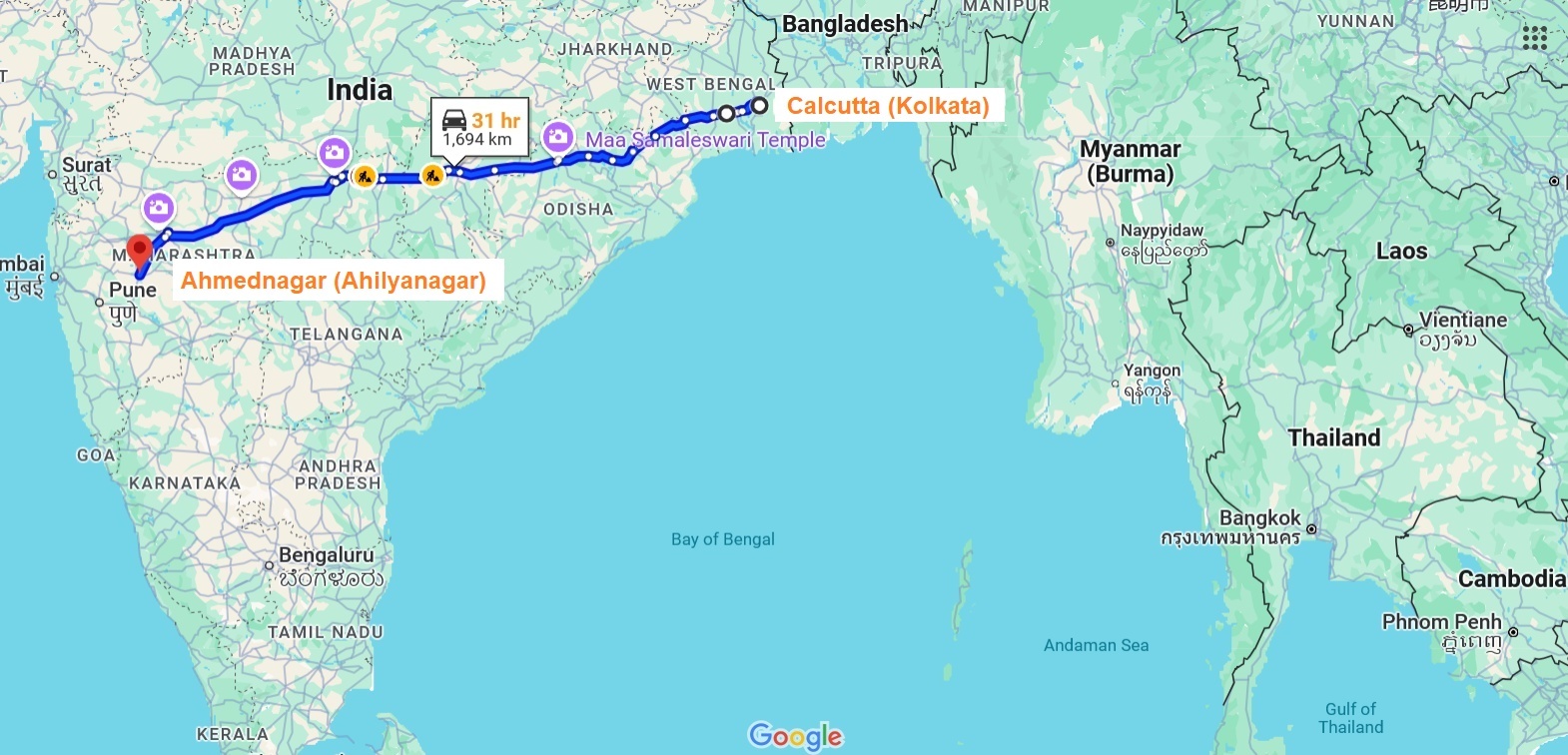
Ahmednagar to Calcutta (approx. 1694Km)
All the vehicles and heavy Baggage were sent on two days previous to our own departure. I have mentioned these two important words, “Baggage and Vehicles,” as I wish to point out later on, what a mistake they proved to be, for the country we were now bound for, “Burma.”
6
Calcutta quay-side - circa. 21 Jan 1942.
On __ Jan. 1942 we arrived on the quay-side at Calcutta after a long and tiring journey from Ahmednagar and the same day we embarked without a single hitch, on board an eight and a half thousand ton ship called the “Karoa.”
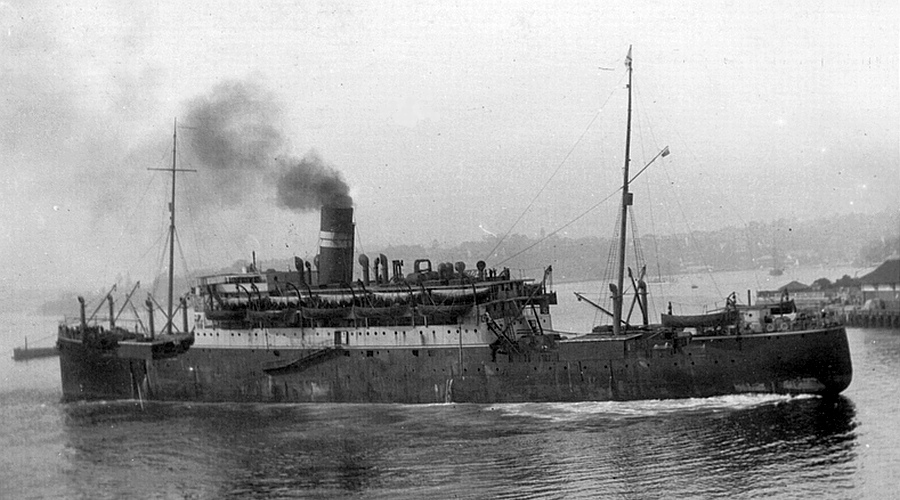
HMT Karoa.
Our heavy Baggage which had been sent on ahead, had already been put aboard, by the harbour porters, at the very bottom of No 1 Hold. This meant, that I only had to give the orders to the already arranged fatigue parties to set to work, and carry the baggage we had with us, from the train, roughly a hundred yards away, and put it into a special, ”Wanted on Voyage Department,” on board ship.
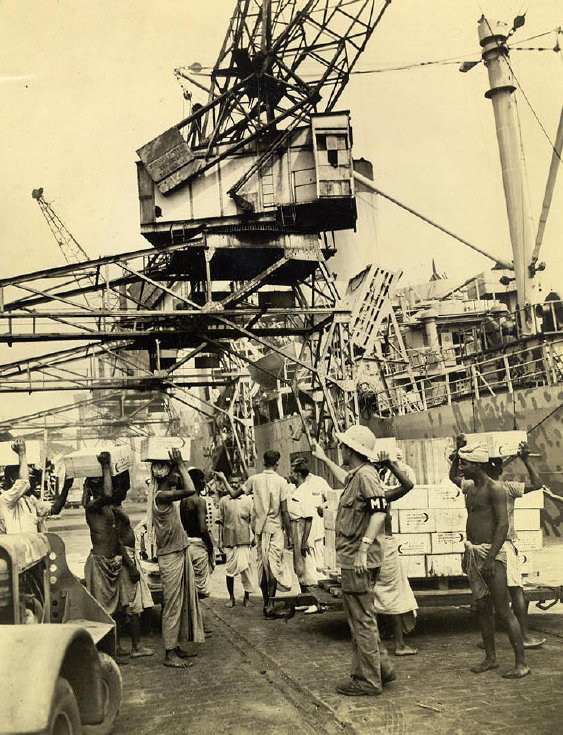
Calcutta dockside mid 1940s.
For several hours, we worked continuously, and apart from the “Wanted on Voyage, Baggage,” we had to man handle all of our ammunition, which was no small matter. We did not quite finish handling all of our Baggage the same day, but finished early the following morning. Everything having been put aboard, and everyone settled down we began preparing for the voyage.
Sentry and look-out posts were detailed, which are so vitally necessary, on any sea passage, during war.
7
These posts comprised of, the now familiar
"A/A posts" quite likely refers to Anti-Aircraft positions on the ship.
A/A posts.
We had ten of these in all, and each one mounted a Bren gun, on an A/A mounting, surrounded in some cases by sandbags, and others by concrete.
We had submarine watches, and these, along with the A/A posts, were patrolled day and night, by both BOs and VCOs who at all times gave good advice wherever necessary.
Boot drill was also carried out on several occasions, and our lads soon picked it up. After a few tryout alarms, they were doing it in the minimum of time and the minimum of panic, which is, what is aimed at, during all such practices.
Two days later, fourteen of our vehicles were put aboard, and some
RIASC (Royal Indian Army Service Corps): Responsible for transporting supplies, and handling ammunition from base depots to forward points.
RIASC
personnel also came aboard, and were accommodated in the remaining deck space.
Our lads, just as usual, and like ourselves coming out from home, and should I say, “Like any other troop ship,” were packed like herring in a barrel. Like ourselves, they quickly settled down, in spite of every discomfort. We, the officers, were each given a beautiful first class cabin, and the VCO’s a 2nd class one.
Convoy SR 4 (Calcutta to Rangoon) 28 Jan 1942 - 31 Jan 1942.
8
We lay in “Calcutta”, for four and a half days, before the anxious day arrived. January __ 42 we set sail, and our ship pointed her nose down the “River Hooglie,” and so to the open sea, “The Indian Ocean.”
Our lads by this time were all quite excited, but they seemed to me, “although it was something they never ever thought they would experience,” to take everything in their stride. As for the old boys who had been to sea before, they seemed to take everything as a matter of course. Actually, after speaking to them, you realised that they really loved the experience, in spite the fact that they knew what lay ahead of us all. Every one of them was grand.
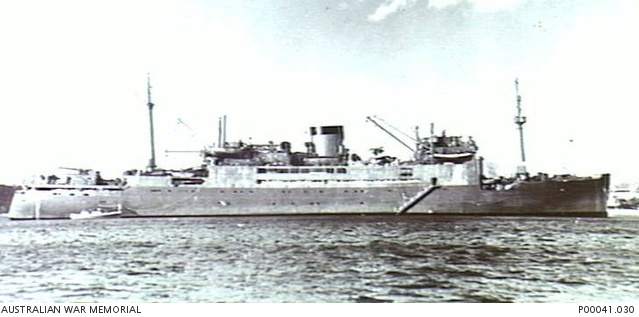
HMAS Manoora 1942 - armed escort to convoy SR 4 out of Calcutta. ref.
click here
Jan __ saw us at the bar of the Hooglie, and there we put off our pilot, and after each ship had done this in turn, we headed out to sea, and soon formed up into a convoy, Eight ships in a row
...missing script...
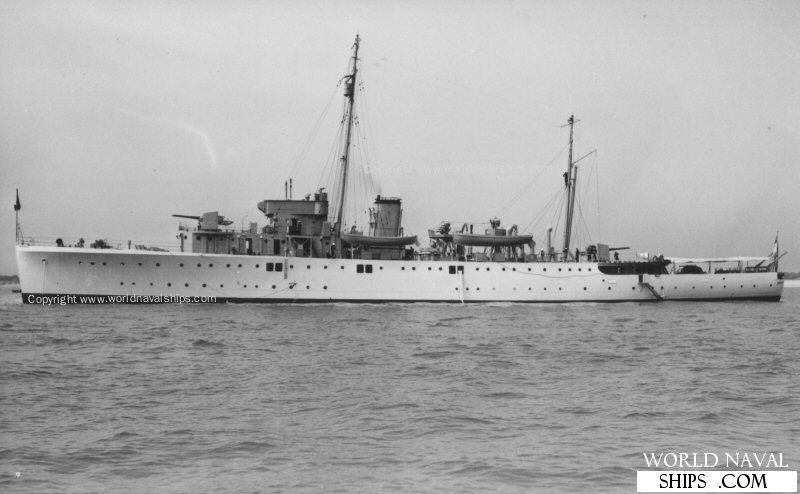
HMIS Indus - escort to convoy MR 1 out of Madras, joined with convoy SR 4 on 29 Jan. ref.
click here
We were escorted, by an
HMAS Manoora
Australian Armed Merchant Cruiser
and later we picked up another
HMIS Indus
small escort vessel.
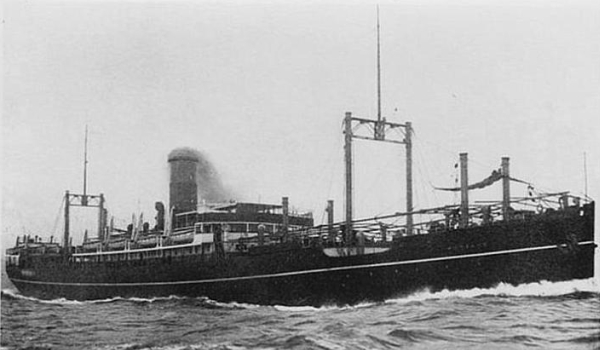
Kutsang-1922 - ship with convoy MR 1 out of Madras. ref.
click here
We steamed due south for the first three days, and on the third day, two other ships from Madras Joined us.
9
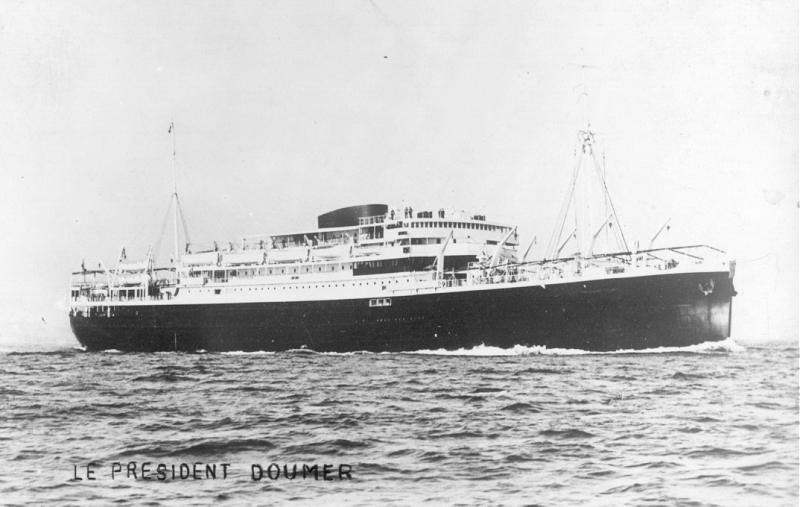
President Doumer - ship with convoy MR 1 which joined convoy SR 4 on 29 Jan 1942. ref.
click here
One ship, I can remember was a
This was the "President Doumer" with convoy MR 1 which joined convoy SR 4. See pic.
Free French ship
with beautiful lines and a squat funnel.
Thus, we sailed in convoy, with each ship in turn carrying out its alarm signals and personnel carrying out the drills and duties which we practised while in Calcutta, and I have already explained in detail.
Rangoon - 31 January 1942.
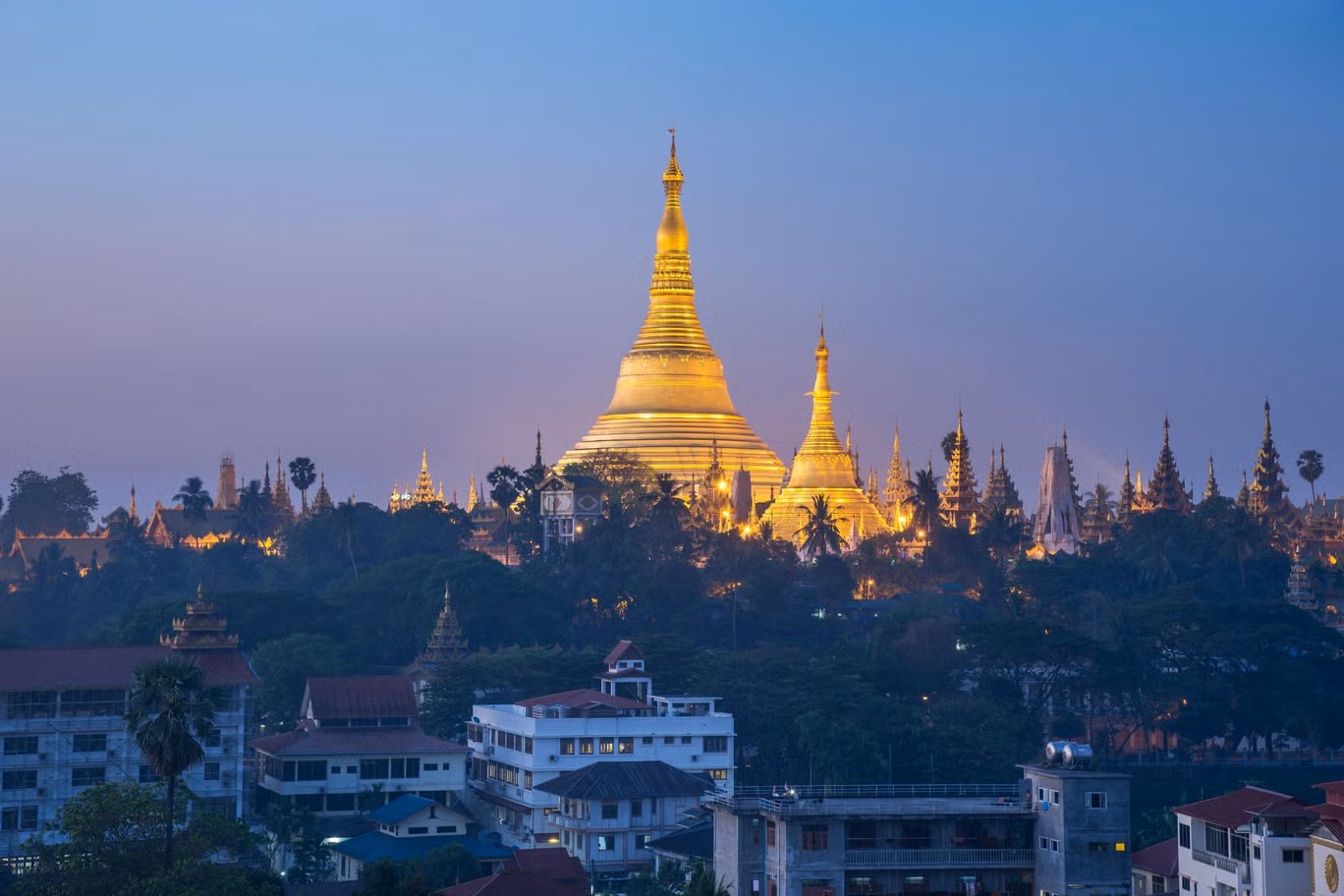
The Golden Pagoda, Rangoon
Early in the morning of the 31st January ‘42. Rangoon was in view, and we could see, in all its glory, glittering in the morning sunshine, - “
Shwedagon Pagoda
The Golden Pagoda
.” -
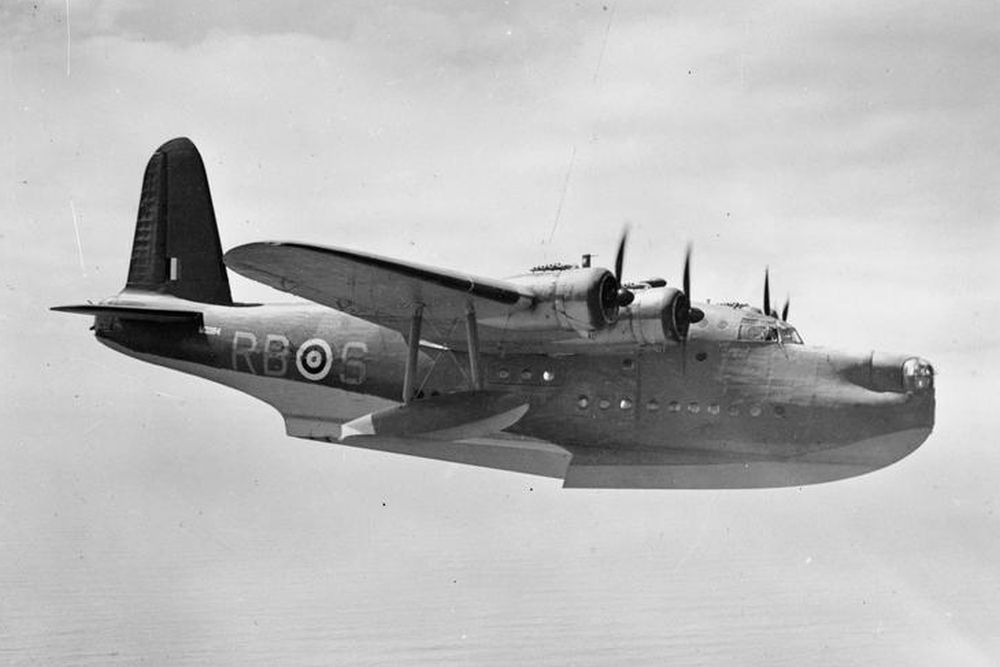
Short Sunderland Mk 2
Another sight I shall never forget was, as we were passing some large storage tanks, a “Short Sunderland Flying Boat,” soared close by, and soon disappeared out of view. To me, this was a most re-assuring sight.
10

Blenheim bomber
Incidentally, we had one or two “Blenheim Bombers” escorting us from two days outside Rangoon. They gave our lads some valuable lessons with regard to recognition and speed etc.
The flying boat, had no sooner disappeared into the blue, when Rangoon, now very close at hand, blew her “Air raid sirens, and our ships started dodging all over the river. How they managed some of those manoeuvres, I sometimes wondered, as the river, at that particular point, was not so very broad.
The alarm did not last long, and we, immediately on the “All-Free” Alarm, proceeded toward the dockside itself. Our first rope, was put ashore, at approximately 1010 hours, and the gangways followed very soon afterwards.
No sooner had we started to disembark, when the Air-raid siren blew forth again, and porters who were waiting to handle our Baggage, before you could say “Jack Robertson,” without exception, had disappeared to a man.
This, is a very important factor, as cranes, which we relied on for unloading our heavy Baggage from the depths of No1 hold were, as a result, out of action.
This, was my particular problem, being once again Bn Baggage Officer. It also meant, if the porters did not return, that every single article on board belonging to us, had to be man-handled, by our own fellows.
As I had already prepared for any eventuality, I had arranged sufficient fatigue parties, to handle the “wanted on voyage” Baggage, and ammunition, and it was done without a hitch.
11
I was given orders to put the Baggage in a certain part of the Warehouse, by an officer who was an absolute menace to me, throughout the entire day. He kept coming up to me, and asking me if I was going to finish by 2100 hrs. He also expected me to have everything loaded on to the train by this time, which was behind the warehouse.
I kept telling him that the job could not be finished, as I knew what our chaps were capable of doing. Nevertheless he kept telling me he had been connected with the job of unloading ships, and loading trains for years, and occasionally agreed that the job could not be finished by the above mentioned time, but insisted all the same.
As darkness was falling, some of the porters and crane-men came ambling back in one’s and two’s. Very soon some of the cranes were working, and my lads who had only a few odd minute rests since we started to disembark, got down to work, and man-handled the heavy baggage from the quay to the train.
Fortunately, more porters arrived, and they made a considerable difference, to our already much over worked boys. We did not finish by 2100 hrs, and my friend was frantic, but he had to quiet down, and give me a half hour’s grace, In which time, we finished, and had loaded to the very roof, eleven narrow gauge railway vans.
I had had nothing to eat all day, and was absolutely famished. My CO, just as we were finishing, brought me a beautiful porke-pye.
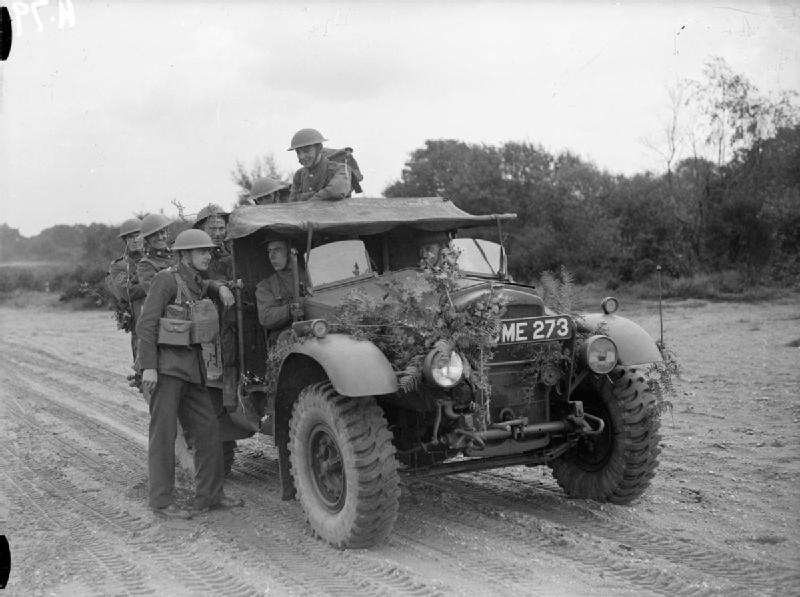
15 cwt (hundredweight) truck (Morris CS8)
We had to leave for our train right away, which was waiting in “Rangoon Station” about one mile away, so I had to eat my porke-pye while travelling in the rear of a 15 cwt truck but enjoyed it all the same.
12
With no other job to do, immediately on entering my compartment on the train, with every stitch of clothing and equipment, I lay down on one of the lower bunks and fell sound asleep.
Rangoon to Hnin Pale - 1 February 1942.
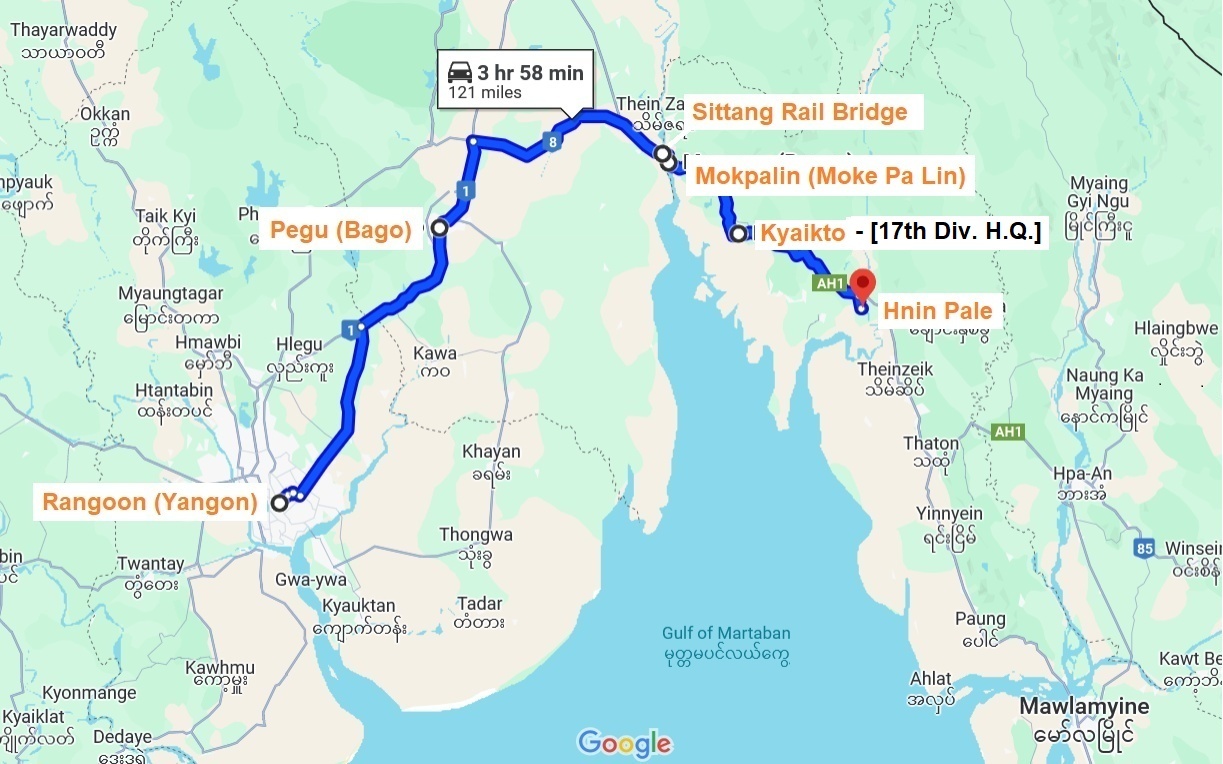
Rangoon to Hnin Pale
The following morning, I was awakened as we were approaching Pegu and I was surprised to see nothing but ‘Paddy Fields’ and not the jungle I had expected.
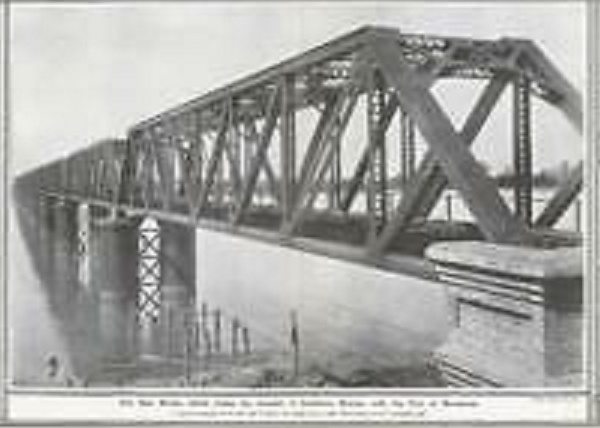
Sittang River Bridge
These thoughts were not allowed to stay in my mind for long, as we passed over the “Sittang River,” from the jungle in scrub ...missing script... form started with a jolt.
Over the “Sittang” we stopped at the first station,
Moke Pa Lin
“Mokpalin”
but only for a short time.
13
The next stop was “Kyaikto” roughly twenty miles further on, but here once again, our stay was short. “Kyaikto,” we found out was the new 17th Divisional H.Q.
The next station “Hnin Pale” was our destination, and immediately the train stopped, the Bn detrained in double time and quickly dispersed.
I called my fatigue parties once again, actually different lads, and we began unloading the Baggage. We had been working steadily for several hours, and had most of the Baggage unloaded, when the C.O. told me that most of it would have to be sent back.
Well, the only thing to be done was to start reloading what things, we did not want. This work was not finished by night, and I went to the Bn area about three miles away, where I was soon beneath a couple of blankets, and sleeping sound. Early next morning we were back on the job again, and very quickly finished it. Now, for a few words about the Bn area.
It was rather a pretty place, with plenty of trees on one side of the road,and scrub jungle on the other.
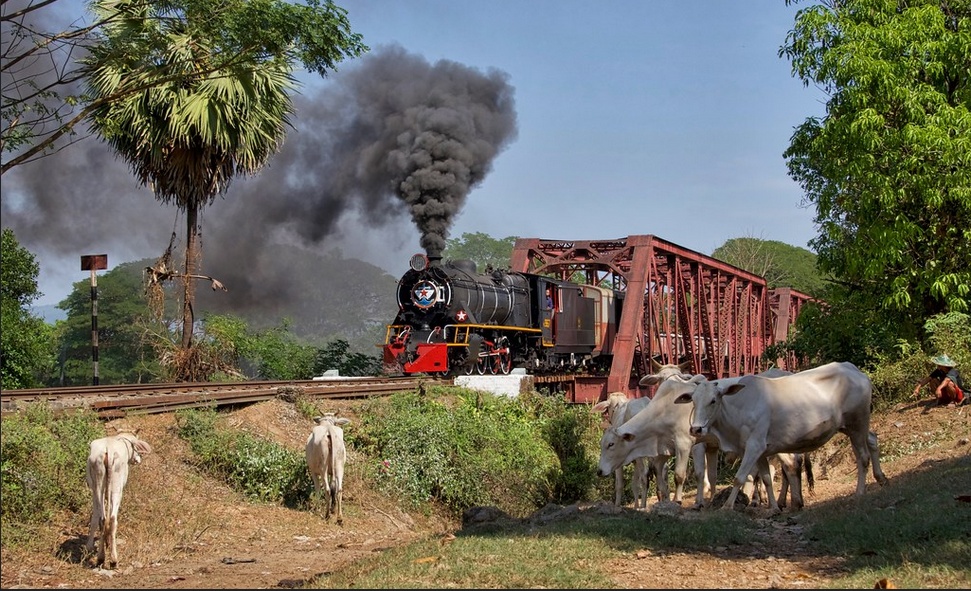
Bilin River Railway Bridge - Hnin Pale
About two miles North of Bn HQ. was the “Bilin River” with two bridges over it. One a Road bridge and the other a railway bridge.
We actually had a Company position close by both.
14
The first morning the Brig. “Ekin” arrived, and he very soon made it clear that our present position was the jumping off one, before going to the front, and he said, “It wouldn’t be long.”
He did say something I shall always remember. These were the words “Concentration of Force laid down in the smallest of
without which you can get nowhere.” He was referring to the scattered positions of the Bns in our
Brigade: During World War II, a brigade in the Indian Army typically consisted of approximately 5,000 troops. This included three to six battalions plus supporting elements. Ref. Google AI.
Bde,
for which he seemingly had nothing to do.
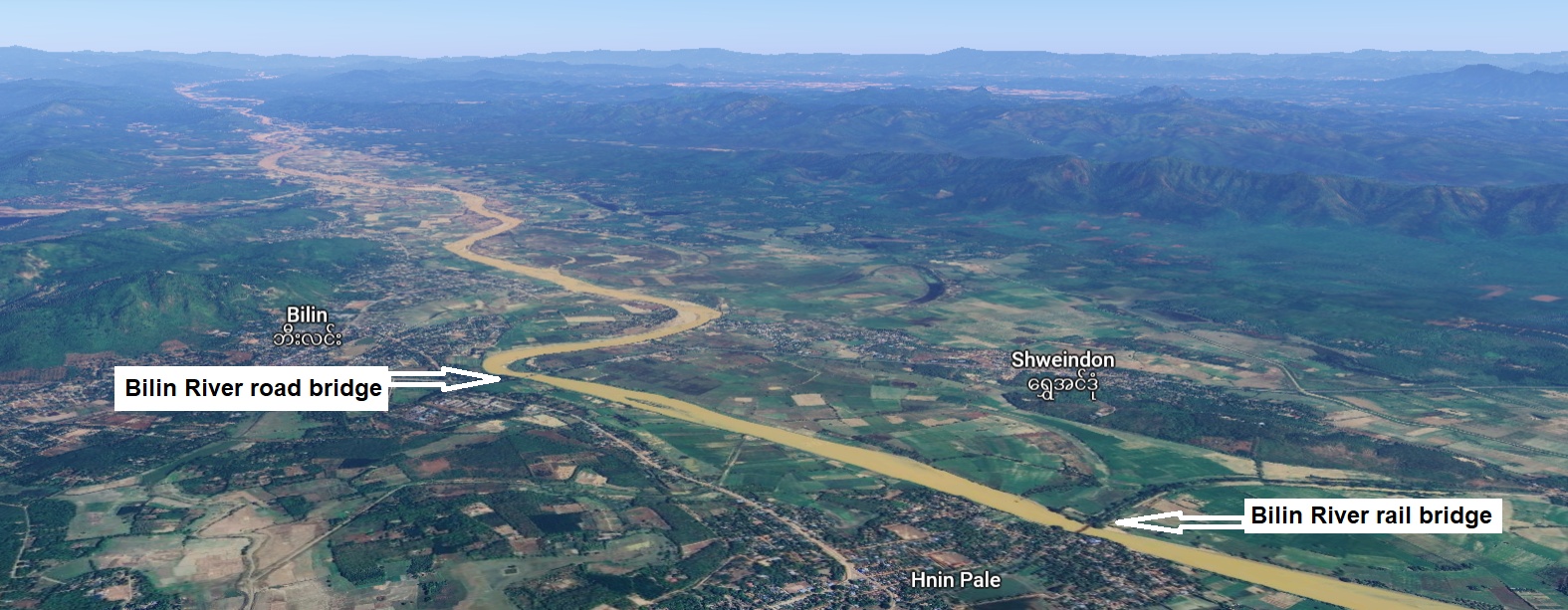
Bilin River Bridges - 17th Div. Coy positioned at each bridge.
All positions had been laid down by the higher command, and he was obviously a very worried person. In command, yet not in command, more or less like a section leader, under his platoon
Havildar - Indian Army non-commissioned officer, similar to British Army Sargeant, usually in charge of a Platoon.
Hav.
Back to Rangoon with surplus baggage - 3 February 1942.
The following day, the C.O. decided that I being baggage officer, should be sent back to Rangoon with the surplus baggage, and at the same time, hand it over to 2nd Lieut Walker who was a reinforcement officer in charge of our Sepoy reinforcements. They were billeted in the Rangoon Gaol.
With me, I also took orders for Walker to move with the reinforcements to “Meiktila” about four hundred miles north of “Rangoon.”
15
I arrived in Rangoon the next morning, after having spent a very comfortable night on the floor of the carriage. It was the only space on the whole train.
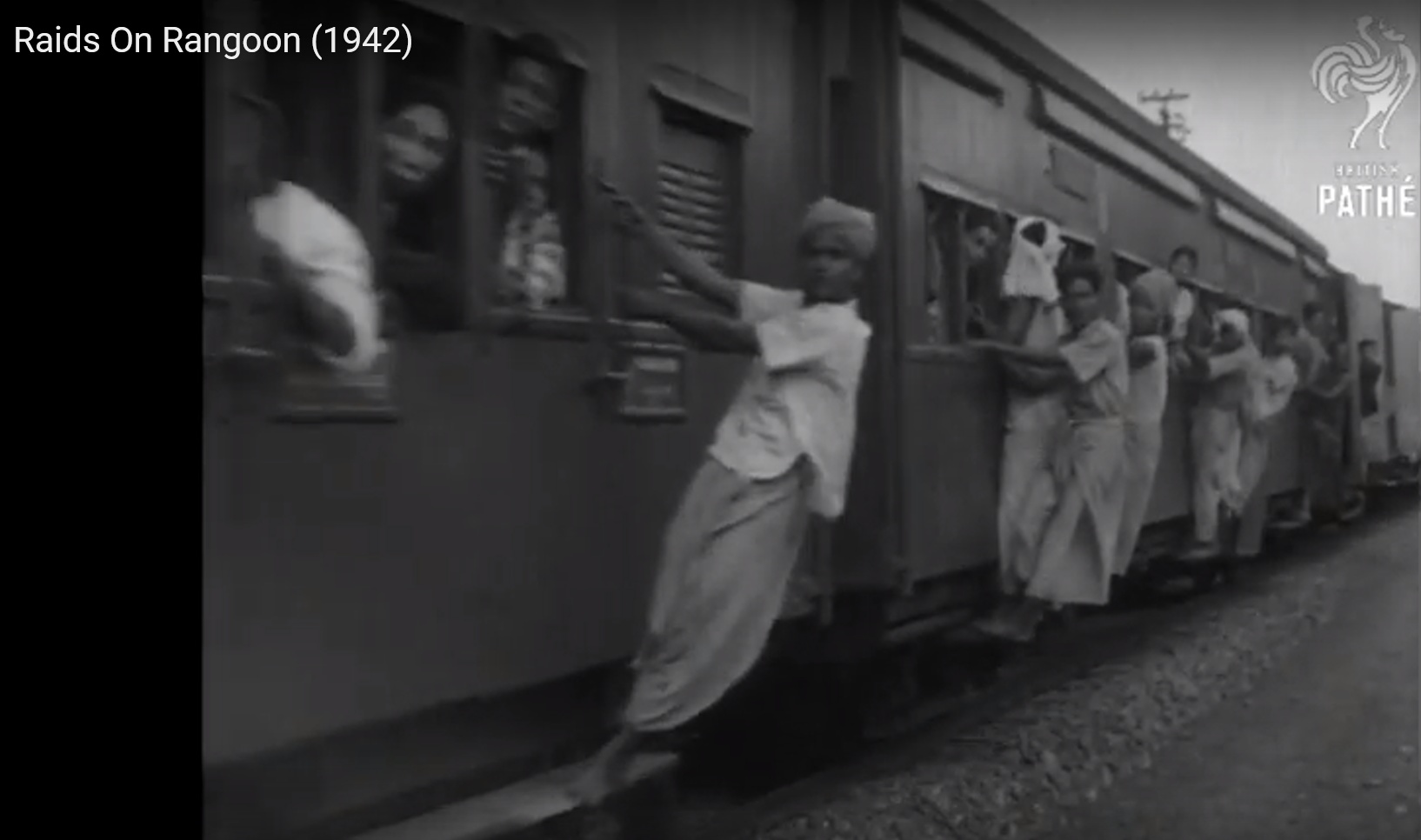
Evacuees, fleeing the Jap advance, "packed like sardines," arrive at Insein Rail Station on the Rangoon circular. circa. Feb 1942 ref.
click here
Evacuees were packed like sardines, and in many cases it was a heart-breaking sight.
In Rangoon I commandeered a taxi, and had very soon handed over the baggage and orders to Walker, who seemed rather displeased. I found out the reason, as he had fixed up accommodation with some people in a home, and how could one blame him.
This job finished, I had to find myself some place to spend the night, but that turned out to be easy. Before I had left “Hinn Pale,” Major Terry had given me the address of his married sister who stayed in Rangoon, so there I went. No sooner had I mentioned 5/17 to Mrs E, and my troubles were over.
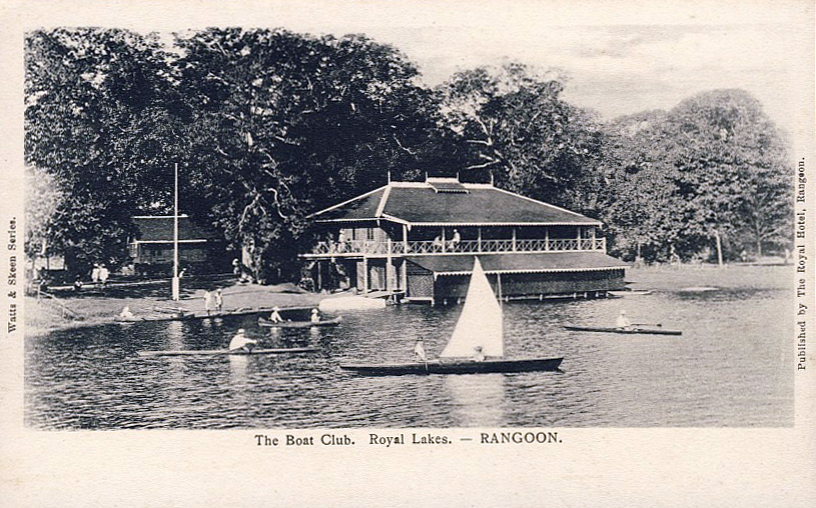
The Boat Club - Rangoon
That evening I was taken to a yachting club, and I spent one of the happiest evenings of my life, sailing peacefully over a beautiful lake. The following morning, after a first class meal, I
...missing script... ends for the officers.
16
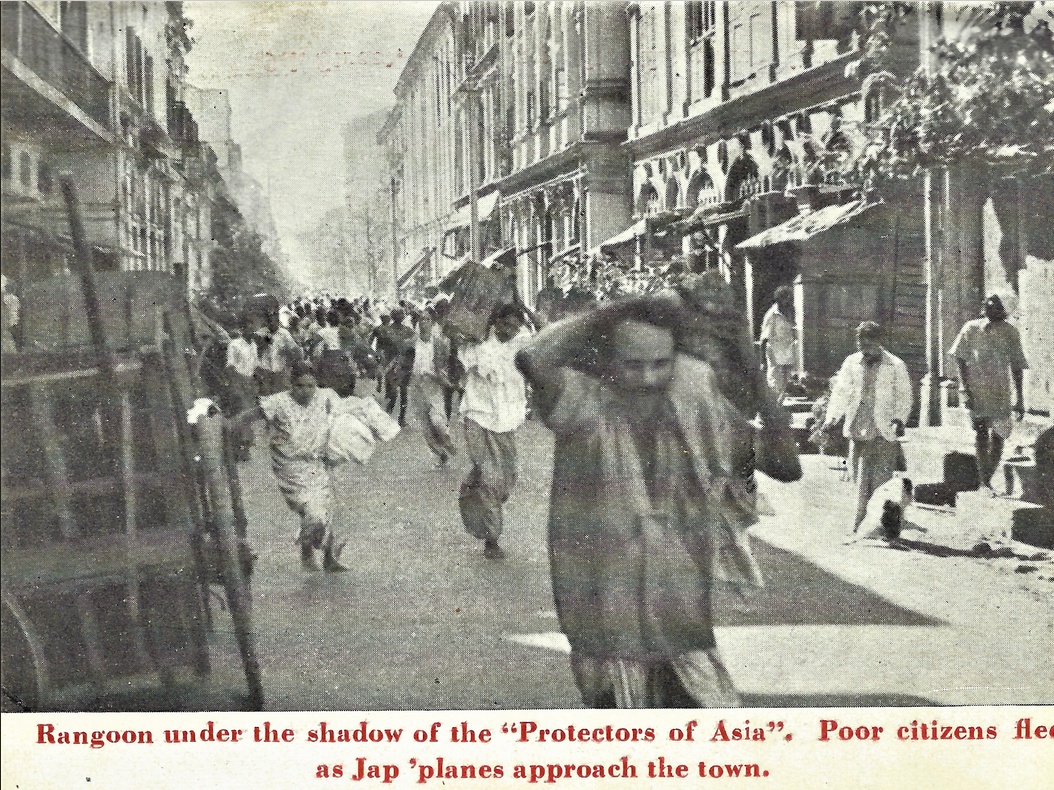
Jap bombing Rangoon circa Jan 1942
Shopping in Rangoon, at that time, was no easy matter, as the entire town was in a frantic muddle, and everything was scarce. I tried all day long, but had no luck in finding what I wanted, and decided to go back to Mrs E again, spend the night, and try the following day. What I had to buy was rather important as far as the C.O. and adjutant were concerned.
On my way back I met ‘Ram Singh’ who had been left behind in Rangoon to look after the
Motor Transport
M.T.
that was to follow. Incidentally, ‘Shaw’ was doing a similar job to ‘Ram Singh,’ only at the other end, in Calcutta. Geffreys, our B.T.O. was also left in Calcutta. I rather put the wind up poor old ‘Ram Singh,’ when I told him, he had been expected to report to the Bn two days ago. He thought I was pulling his leg, so I left it at that, not being able to argue with him.
Early the following morning I was up very early, said goodbye to Mr & Mrs E., and raced down the town. Fortunately, after searching for two and a half hours I found what I was after, in an out of the way street.
From here I went to the only remaining Cafe’, and had something to eat. I actually finished up with strawberries and ice-cream. I bought a few eats for the officers, and proceeded to the station, which was not far away. A train, as they said in he last war, “was going up the line,” in about two hours, and I parked myself on the platform. It was here I saw some really heart-breaking sites. There were evacuees in the hundreds, yes, possibly thousands, and I should like to say a few words about it.
17
As we all know, Rangoon had been bombed ever since the Japs had captured “Penang” in Malaya, and everyone had been shaken up rather badly. In fact, many of the people had left altogether. Although, not so many bombs fell on Rangoon
...missing script... a turmoil, services of every description were thoroughly disorganised and everyone was going around in a flat spin.
I am not speaking of the few remaining white people. Army H.Q. was also in Rangoon, and had taken over all the university buildings, which were spacious modern ones covering several acres. In the opinion of the British population in Rangoon, this was the laughing stock of the place. The reason I shall leave to your own imagination. They moved up to
a hill station in Northern Burma, before Rangoon fell.
The trains, were another example of what the population was like. During my two hours in the station, two trains came in simply swarming with human beings. Inside, they were packet so tightly, one wondered where they found any breathing space. People were outside on the running boards. They were sitting on the buffers between the carriages. They were on the coals, and even on the front of the engine.
In fact everyone couldn’t get away quick enough. How this state of affairs was ever allowed to happen, it was a disgrace, and there I was sitting and able to nothing about it.
There were no troops on the station at that particular time and one or two fights started up, which my orderly and myself stopped with the threatening muzzle of a rifle.

Lee-Enfield No. I Mk III - standard infantry issue, Indian Army WWII.
18
Rangoon to Duyinzeik - 6 February 1942.
Remarkably enough, my train left only thirty minutes late, and I was soon on my way up the line, once again. Passed Pegu, and on to “Sittang River.”
While passing over the bridge, this time in daylight, the thought struck me that, if ever the Japs were able to come this far, it was going to form rather a bad obstacle to cross, for our army in Southern Burma, if we did, ever have to come back here. In other words, it struck me a none other than a bottle neck, of the worst possible type. In fact everyone who did pass over the Sittang bridge in daylight, thought exactly the same
...missing script... the higher command seemed to ignore the fact altogether, and tried to defend the wrong side of the bridge.
Over the “Sittang,” past “Mokpalin” and on to “Kyaikto,” where I had to report - 17th Divisional H.Q. - Darkness was closing in, when we stopped, and by the time I had found Div. H.Q. and been given my orders it was about 10’ o’clock at night. They informed me the Bn had moved, and I had to go to “Thaton” by rail, and from there to
Duyinzeik (Du Yin Seik) on the Donthami River.
“D “
by road. I was also to proceed immediately by the train which was then in “Kyaikto” station, about one mile away.
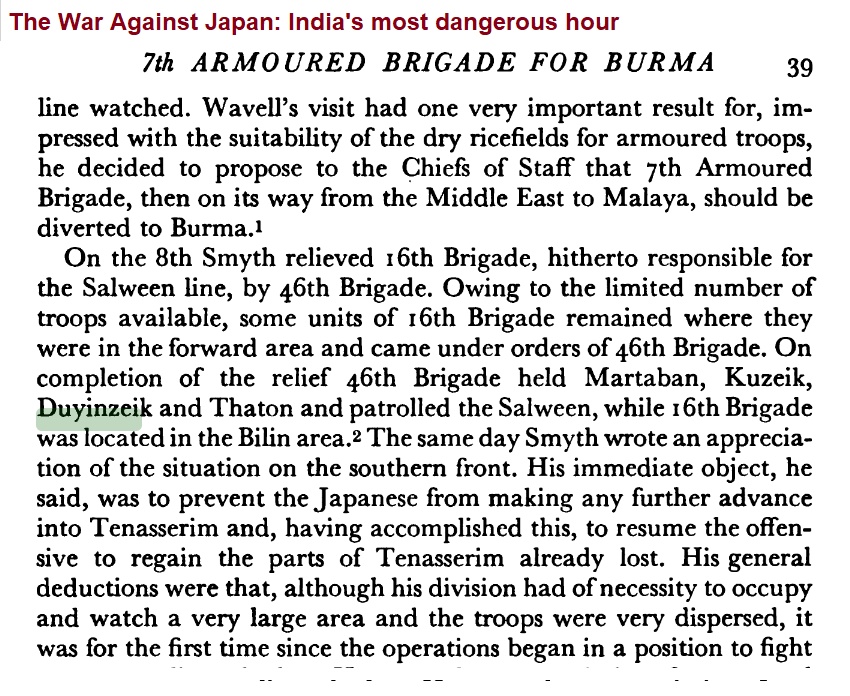
46th Brigade held Martaban, Kuzeik (Bar Kat), Duyinzeik and Thaton.
19
I was provided with no vehicle and had to walk. Consequently, the train had left by the time I arrived at the station, and had to sleep the night on the platform. It, being more comfortable than the already overcrowded waiting rooms. The train came in about half past five in the morning, and with much effort I pulled myself from the warmth of my sleeping bag, into the cold night air, and boarded the train.
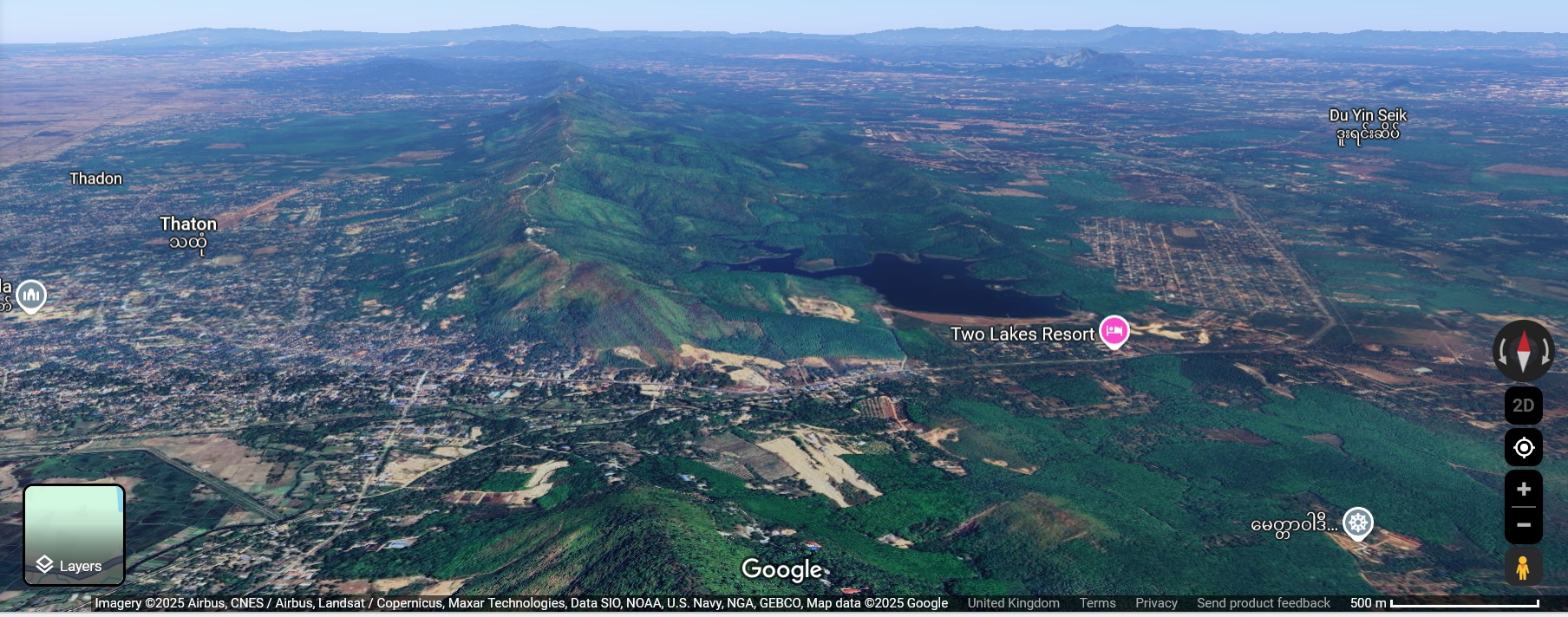
Thaton - Duyinzeik (Du Yin Seik).
We arrived in “Thaton” about 7 o’clock, where I was given a glorious breakfast by a Lieut. Col. in charge of movement control. I forget his name. He also provided me with a lorry which I drove down to
Duyinzeik (Du Yin Seik) on the Donthami River.
“D “
about twelve miles away.
Our
Motor Transport Officer
M.T.O.
not having arrived, I had to look after the M.T. and do any other odd job that cropped up. Incidentally, we had fourteen, 15 cwt trucks, and about two 30 cwt water waggons.
This
the
The Baluch Regiment recruited from Baloch (bordering Iraq), Pathan, Punjabi Muslim, and Dogra tribes.
7th Baluch
were moved down to the
This would be Kuzeik (Bar Kat) West bank of the Salween (Thalwin) river, opposite Pa-an on the East bank.
Salween
River, about twelve miles south of our position, and across the Salween roughly nine hundred yards from Pa-an. They were going to take over from the 1/7th Gurkhas
At eleven o’clock
the 1/7th came through our position and we learned the Japs had Level-bombed, Dive-bombed and shelled them when the Baluch were taking over. The Gurkhas stayed with us for the night, and pushed off for Bilin, early the following morning.
I found the Bn in position, on either bank of a
Donthami River.
small river
, round about a ferry, for which they were responsible. The ferry, was only a raft made with large bamboo poles lashed together. To operate this contraption, six to ten of our lads stood on one side, and pulled on a thick rope, which was stretched right across the river, and fix to a tree stump on either bank.
20
The 46th Bde. was now in position as follows. - The 7th Baluch on the “Salween River,” opposite “Pa-an.” The 3/7th Gurkhas also on the Salween, opposite “Moulmein”, and ourselves 5/17 Dogras at “D .“
Duyinzeik - 13 February 1942.
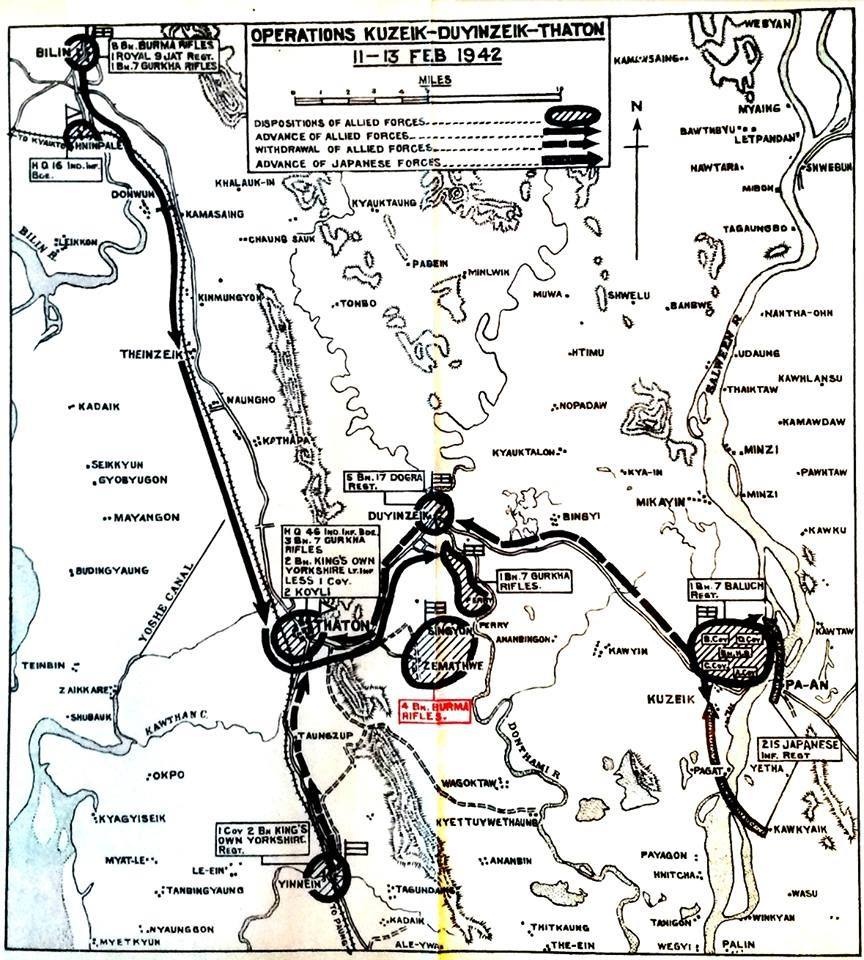
Operations Kuzeik - Duyinzeik - Thaton
The Baluch had not been in position for long, when the following day, small parties of them came wandering back through our position, one by one, and all looking the worse for a
They did not fail to tell our lads everything. Telling them that the enemy was everywhere, and we did not stand a chance. They even told our lads there was a general withdrawal. We had quite a time with them, as it was causing loss of morale. They certainly shook our boys when they described how the Japs were using their aircraft, and bombing hell out of them.
21
This seemed to have some effect, as two of our VCOs and thirty odd men went off without an order, but were sent back by Bde. H.Q. in “Thaton” the following morning. We had just plucked up the lads courage again, when we were well and truly bombed.
A formation of fourteen bombers escorted by fighters came over, and dropped their load of
"A.P. bombs" likely refers to "Anti-personnel" bombs.
A.P. bombs.
We had very few casualties, but loss of more morale, not having seen any of our own planes, and more especially, when three Sepoys in one Slit-trench had all been wounded. Slit-trenches, had been pumped into our lads for months, and they came to us asking, “What do we do now, when Slit-trenches are no good?” This fortunately, was easily explained, as an A.P. bomb burst on a large tree above this particular slit. Trunk and all the muck came straight down on
...missing script... planes were over again, and gave us more.
That day, I had to go down to “Thaton,” on duty, and they bombed there as well, leaving not one single building standing. The same afternoon, two companies from the
King's Own Yorkshire Light Infantry.
K.O.Y.L.I.
joined us. In the evening, I along with one of their officers, finished off a whole bottle of Scotch. We had no sooner finished it, when the K.O.Y.L.I.’s were
and we had to report to my C.O. Both in a very unbalanced state of mind. I thanked my lucky stars when I was told we were not moving. Only one company was going out on patrol and it was not mine so I rolled back into my lair in the jungle.
Withdrawal from Thaton and Duyinzeik - 17 February 1942.
The following day, the 1/7th Gurkhas rejoined us, and it certainly made a difference to everyone, as The Japs had been reported in large numbers, not far away. That night there was firing, but mostly from our own, by now rather nervous lads.
22
Ram Singh arrived with more vehicles the next day and we had to put these under cover
"ek dam" - Hindi for “immediately”
ek dam.
At 5 o’clock the C.O. told me I had to go into Thaton with all the equipment, that could not go on the trucks. The position was at that time, I may not be able to through to “Thaton.” On the other hand, if I did, I may not be able to come back.
This was due to the fact that, the Japs had been reported to be advancing quickly up the “Martaban” Road, and were almost in “Thaton” itself. The 3/7th Gurkhas were now in “Thaton” having had withdrawn from “Martaban.”
It was while unloading the trucks onto “Thaton” station, that I was told the 3/7th Gurkha
L.O. [Line Officer] - a military officer who is eligible for command of operational, tactical or combat units.
L.O.
2nd/Lieut. Jolliff had been killed and our Capt. Richard Ball who had taken Jolliff down to “Martaban” in our carriers was missing.
“Ball” was our first officer casualty apart from the Doctor, Lt. H.P. Mehta, and it is a funny thing, that “Ball” always said, “If there are
...missing script... most regretfully, he was first.
The kit I dumped on the station, much to our later disappointment was all lost, owing to the train never turning up. After unloading, I grouped my vehicles together, told my drivers at all costs to follow me and keep closed up. This they did, and we got through safely, although I did not like the look of things, when we started out.
Once back, we loaded up all the empty vehicles and prepared them for going back along the road under command of Capt. Buisra Q.M. and Ram Singh M.T.O. They moved off about half past nine, and we learned later, they just got through.
23
The reason for sending all the extra baggage back, was that the 1/7th Gurkhas and ourselves were going to march across country to “Bilin,” forty miles away.
The Japs by now, were almost in “Thaton” on one side and another pincer was working round by our rear towards “Bilin” making a wide detour.
Gruelling cross country march, Duyinzeik to Bilin - circa. 18 February 1942.
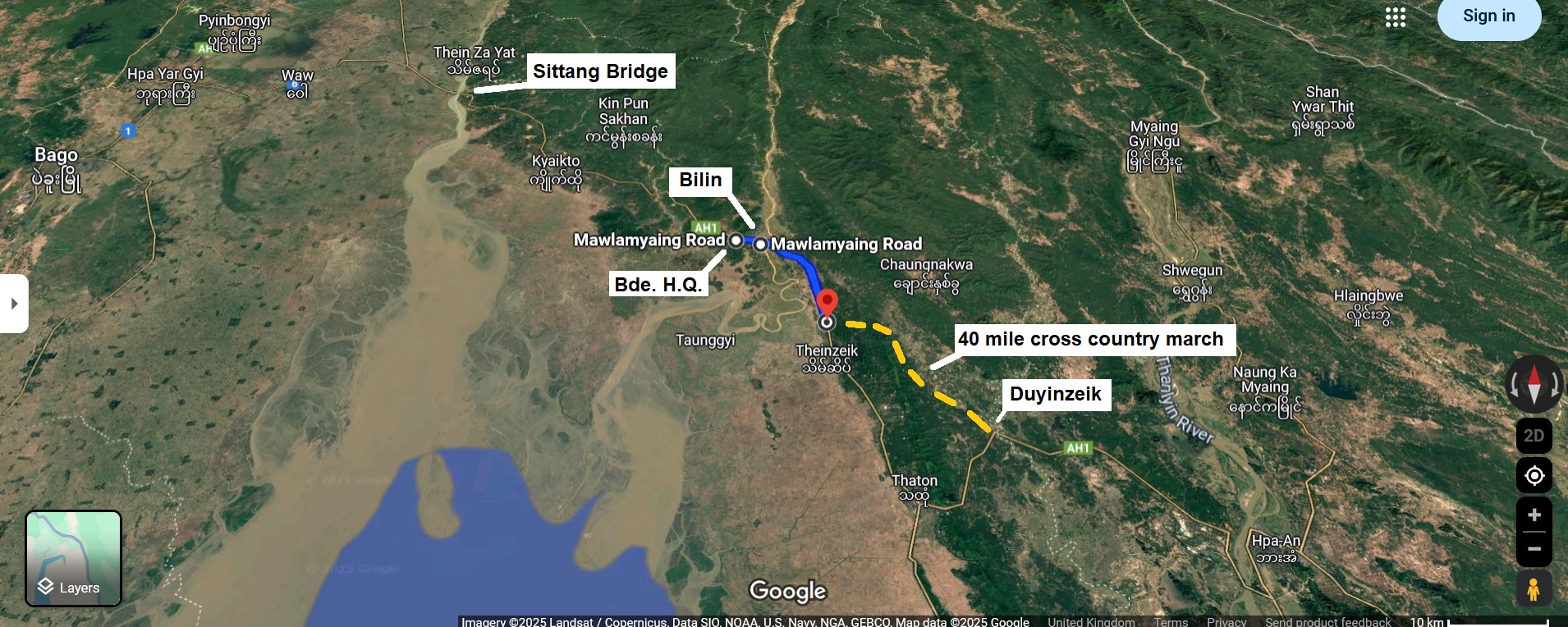
40 mile cross country march - circa 18 Feb 1942. ref. image source:-
click here
The signal for us to move, was supposed to have come through at about eleven o’clock that night, and did not come through until one o’clock the following morning. We learned three days later, there was so much firing in “Thaton” we were almost forgotten about.
However, the signal was given and the two Bn.s were on the march, both strung out in single file, marching through the jungle by very narrow and difficult tracks, lead by our own 2nd/Lieut. Thompson.
He did a marvellous piece of work leading us. We all wondered how on earth he did it. “Good lad was “Our Tommy” at all times.” Never a grouse, or a bad word against anyone.
24
Early the next morning, we halted in a place we called “The Garden of Eden.” where we had a good rest, wash and brush up, and at half past six in the morning we were on our way once again the 1/7 Gurkhas leading. I was in front of the column with our Bn guides.
At half past four, we reached the main road, between “Thaton” and “Bilin River,” after winding our way through very thick jungle. This, was while crossing over the hills which run in a southerly direction from “Bilin River” to “Thaton.”
As soon as we arrived at the road, and I along with my guides had to march on for another eleven miles, to a Rubber Plantation two miles North of the river. A 1/7th Gurkha Capt. and his guides also came along. We had never experienced a march like these last few miles in all our lives, and yet, although dead tired, our feet about three times their normal weight, we kept up a good pace.
We Passed other Bn.s on their way back to “Bilin.” Our boys were becoming more tired out, with every step they took, and we eventually decided to leave them by the side of the road, and go on ourselves. Most of their feet were in a bad condition.
A mile further on, we came to the Bde. H.Q. in the Rubber Plantation, and when the Staff Captain saw me he said, “What the hell are you doing here? Your Bn is going into
six miles back."
I really didn’t know what to say, as I was almost speechless but the Brig. said I had to stay with them the night, and return the following morning. This I did, after collecting my men who I left by the road-side, and soon fell asleep, on the two front seats of a 15 cwt. truck.
25
Next morning, after a good meal, I returned to the Bn and was with “C” Coy in a reserve position. The Bn was in position astride the road, in thick scrub jungle, with a few Paddy fields, dotted here and there.
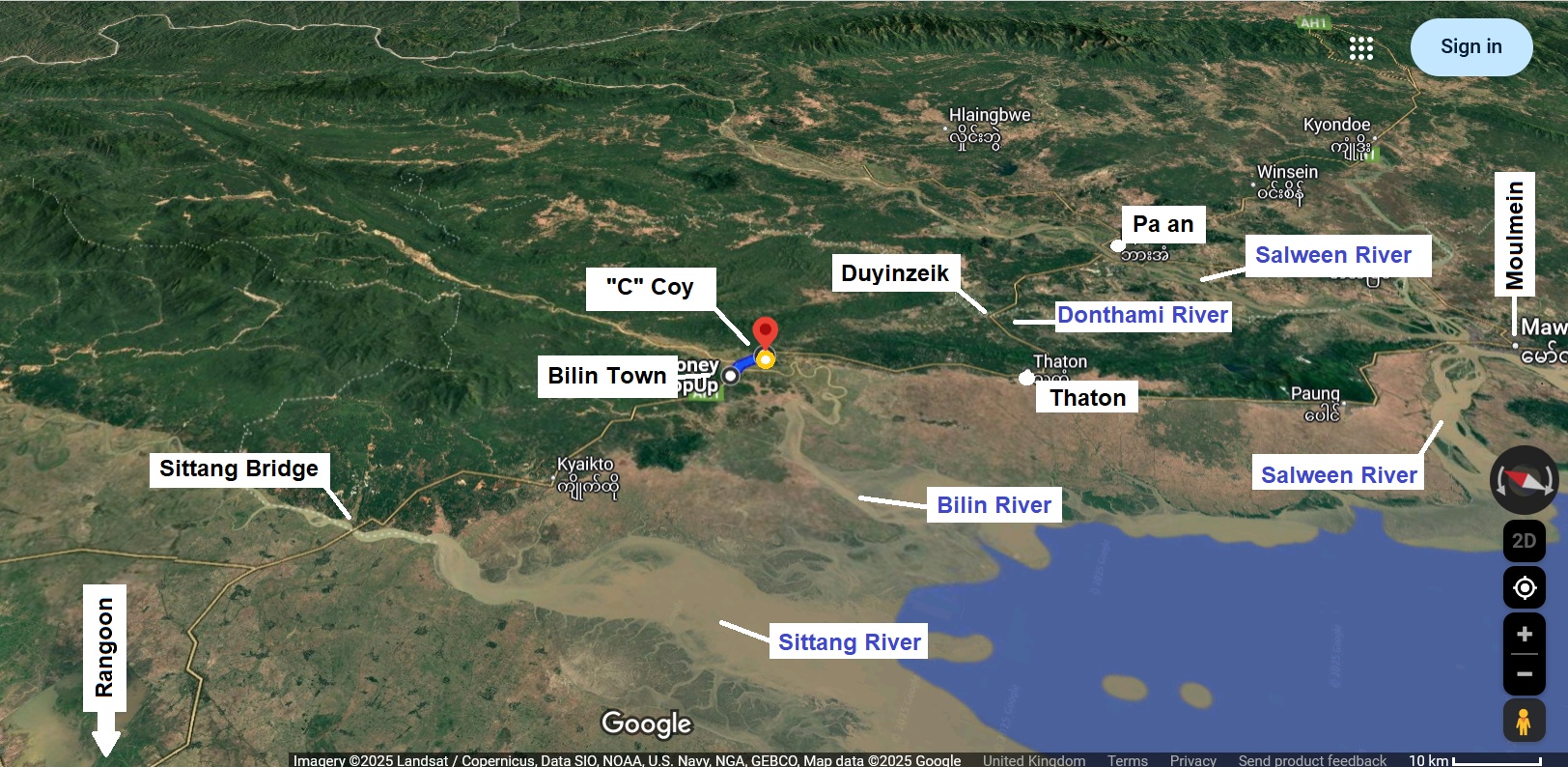
"C" Coy position on Bilin - Thaton road - circa. 18 Feb 1942. ref.
click here
No sooner had I settled down, when the C.O. asked me to drive into Bilin town, as I knew it, and see if I could buy some things for the officers. Things such as razors etc. I drove in but found the whole place deserted except for
...missing script... type of hat.
I certainly didn’t like the look of this, and on my way back, reported it to Bde. Incidentally, they proved to be Japs. I went back to the Bn without being able to purchase a single article.
I joined the Coy. again and remained at peace until the following evening. I mean, I was able to concentrate on the Coy’s work, along with Jock Ferrier. That night, something was in the wind, as our patrols had reported several enemy patrols not far away, so I was called to Bn H.Q. to do a job there.
At half past three the next morning, one of our Coys opened up fire, and was followed by other Coys, and mortars. We had quite a time bringing the firing under control, and it went on for nearly two hours.
26
About eleven o’clock, word came through from Bde. that we had to withdraw over the river, as the Japs were reported in large numbers, supported by tanks, only five miles from our position.
Battle of Bilin River - rearguard action by 5/17th Dogras
19 February 1942.
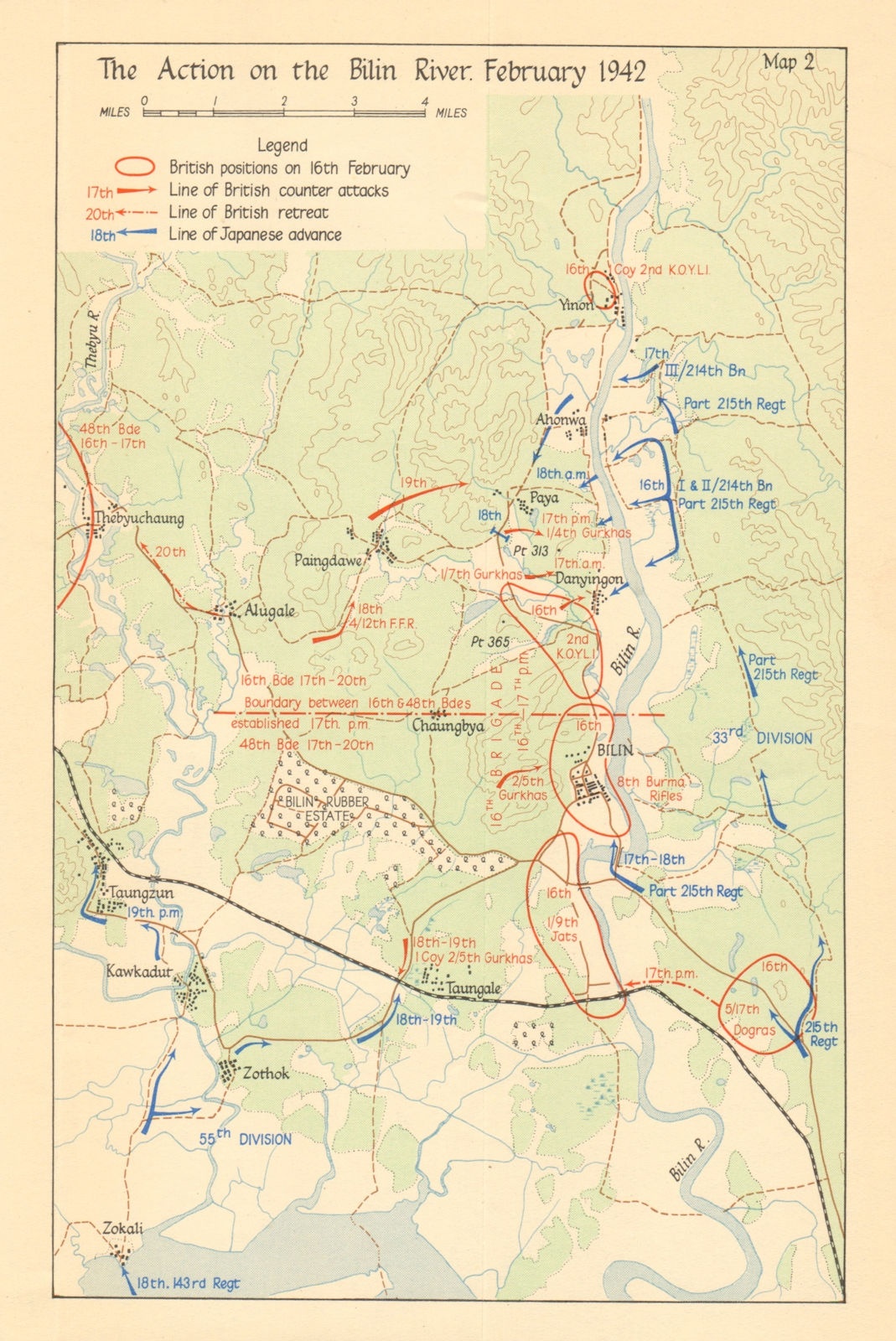
Antique map of the Battle of Bilin River - rearguard action by 5/17th Dogras (incl. 2nd Lieut. F. G. Smith) - 19 February 1942.
Provenance pg.94:-
click here
At twelve o’clock the Bn was starting to withdraw. The mortars and
Probably Vickers Medium Machine Guns."
MMGs
were on the trucks, and the Japs opened up with all they had. They began with firing two mortar bombs at a narrow wooden bridge, about three hundred yards behind Bn.H.Q. and blew it to hell, leaving our truck with the MMGs stranded. We found this out later, when the machine guns never turned up.
27
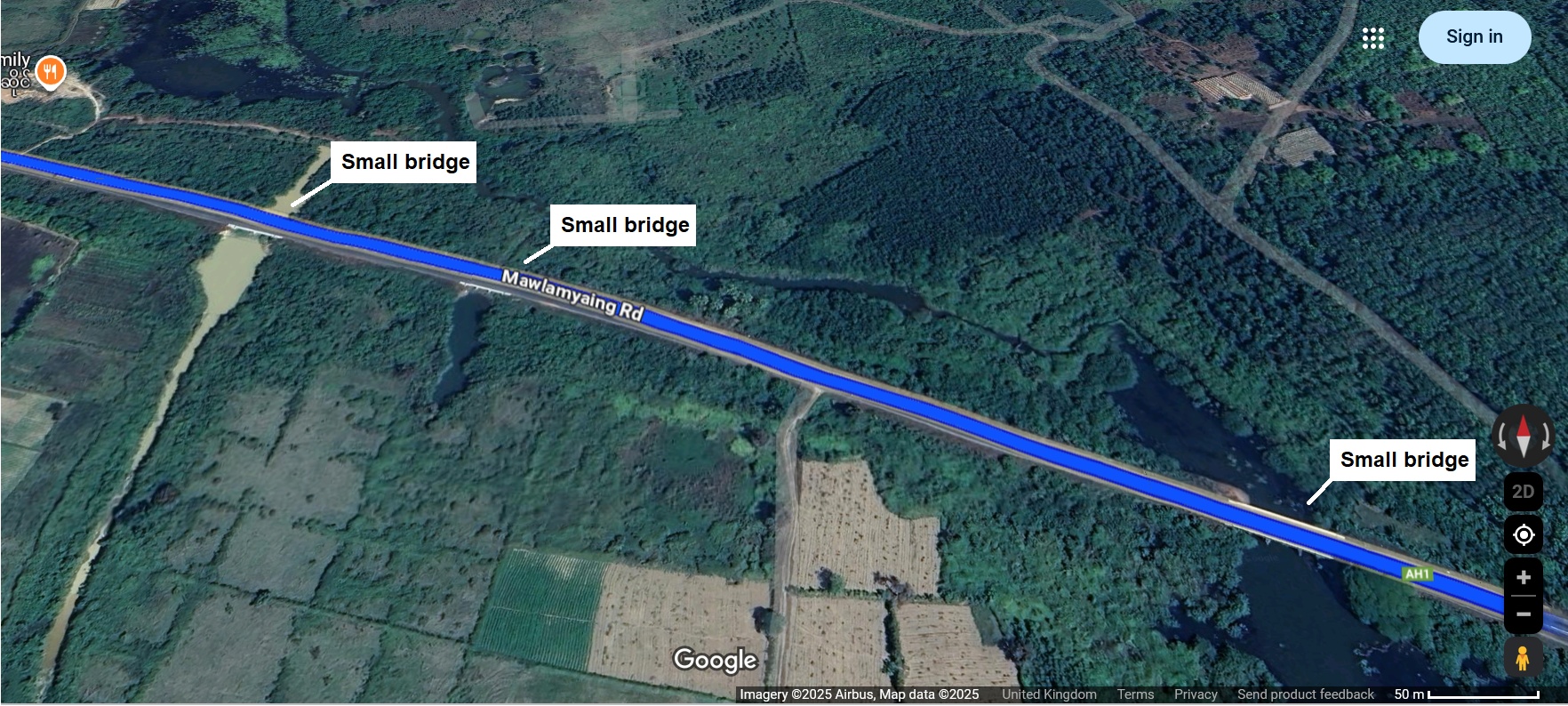
Three small bridges on the Bilin - Thaton Road approx. where the 5/17th Dogras are shown to be on the antique map above. - 19 February 1942.
Ferrier and myself, along with “C” Coy fought the rearguard, and by the time we had finished covering the withdrawal, the Japs had come right round and cut off our own withdrawal. They were all round us except for one side which was more open, owing to the presence of a few paddy fields.
Their mortar fire had already taken a considerable toll of our lads, and I was scrambling through the jungle trying to find any wounded, but all had been deprived of this life. I took their rifles, ammunition and identity discs.
We now decided to fight our way out, cutting through the open flank, and make for the Bilin River
...missing script... of the paddy fields, when the Japs opened up from the bushes from three sides. We had to go to ground, and take cover behind the small bands dividing the paddy fields.
We opened up and pumped hell into them. Buishi Ram, a
Indian Army Corporal.
Naik
of mine, with an
Light machine gun.
L.M.G.
must have alone accounted for thirty
...redacted description of the enemy...
Two Japs stood up in the middle of a clump of bushes, and were waving a white handkerchief, beckoning to us to go over there. One shot from my revolver
...redacted description of an enemy death...
28
Our party was now about thirty strong with Jock Ferrier, Jem. Dewan Singh, and myself, and our only way left was to make one section give covering fire, while the others withdrew as far as they could. After doing this several times we were all under cover of the jungle and made a quick B line for the river.
The fight had lasted for a steady two hours ten minutes, and we were all extremely worn out. It took all the guts we had in us to reach the river.
Arriving at the river bank, we found Capt. Parker and Thompson directing our lads across a ford chest deep. We went across here, holding rifles, Tommy Guns etc. above our heads. It was necessary to cross the river by this ford because both bridges, which I have spoken about before, had been
On reaching the other bank, Thompson and myself collected about forty men, and made our way back to “Hninpale” station, where I met
the "
" C.O. The first thing he said to me was “Good God, where on earth have you come from, and who are you?”
When I told him he confessed he knew nothing what-so-ever about us. Naturally I was rather thunderstruck, and could hardly utter a word, as he was supposed to have been covering our withdrawal. However, we did manage to scrounge some tea off them, and their medical officer dealt with our more seriously wounded cases.
After a quick cup of tea, I took a party of forty four men, and was going down to our new Bn area when the Japs opened up with their mortars
...missing script... as half a dozen mortar bombs were dropped very close by. They caused only a few minor wounds to some of my men, but the party broke up in search of cover, and Capt. Parker and myself arrived at Bn H.Q. with only a handful of men.
29
This turned out to be the case with all the Bn and we, the officers, had quite a time searching the jungle. Very soon we had collected nearly half the Bn with which we went into position.
Battle of Bilin River - west bank - circa. 19 February 1942.
Firing on a large scale continued throughout the night, and no one was allowed to sleep for very long. During the early hours of the morning I was with Bn H.Q. and Capt. Parker and myself lay down for a short rest. It was so cold, and every stitch of my clothing was so wet, from crossing the river, that we had to more or less lie arm in arm, to keep in what warmth we had left.
We had no blankets and used some dry leaves, but we were too cold for them to have had much effect. It continued until the sun rose, and then fortunately one of our mess orderlies arrived with three flasks of boiling tea, which we drank eagerly.
At twelve o’clock that morning, a
of our Blenheims came over and bombed the Japs on the other side of the river. This was the very first occasion on which our lads had seen our planes in action and the effect it had on them was terrific. Every man was on his toes, thrilled to no end.
The bombing had no sooner ceased, when 15th and 28th mountain batteries opened up somewhere to our rear, and helped things even more. By things, I mainly mean morale, which was at that time very low.
I was also enjoying all this support, along with over forty others of my lads, when Thompson came up to me, and said that I had to report back to Bn H.Q. as I was going to do a job with Div. H.Q.
30
Transfer to Div H.Q. at Kyaikto - 20 February 1942.
I made my way back to Bn H.Q. and found out to my bitter disappointment that I
...missing script... job as movement control officer on the Sittang Bridge. Unfortunately I also had to give up my Tommy Gun as well to the
which made me more annoyed than ever.
Ferrier and Thompson were being sent back to “Kyaikto” to prepare for the Bn moving back to there, for the purpose of reorganising. All three of us travelled back together in a 15 cwt truck, and reported to Bde. H.Q.
I was then sent by the Brig. “Ekin” to Div. H.Q. where I met the
Deputy Assistant Director of Ordnance Services.
D.A.D.O.S.
Major
...unclear word... Williams for the first time. He took a great interest in me, possibly owing to my looking as I did. I had the same clothes I had been wearing for just over two weeks, and the growth on my chin was about three days old. The only articles of clothing apart from what I was wearing, I was carrying in a small case under my arm.
The D.A.D.O.S. after giving me a cup of tea, saw me to the
Assistant Quartermaster.
A/Q
’s office, who gave me my further orders. I went down to Mokpalin by the next train and there reported to the movement control officer, but he nothing what-so-ever about me, and I went back to “Kyaikto.”
For over three days I had had no food, and consequently was feeling more than hungry. On Arriving in “Kyaikto” I made straight for “D” mess in Div. H.Q. and had a wonderful meal.
It was while eating this meal that I met an officer by the name of “Jobesan” he was a captain in the
Royal Indian Army Service Corps.
R.I.A.S.C.
He was really a God send to me, as he ended up by giving me a complete set of new clothing, and a bed for the night.
31
That night Div. H.Q. had been given orders to move back to “Mokpalin,” and I moved back there the following morning along with Jobesan in one of his 15 cwt trucks.
Arriving in “Mokpalin” and seeing what it was like, “Jobesan” decided to move his outfit to the other side of the river and set up his depot. He did this but the
Commander, Royal Indian Army Service Corps.
C.R.I.A.S.C.
had something to say against it, and Jobesan had to move back to Mokpalin.
Command of reinforcements camp, Mokpalin - 21 February 1942.
I was dumped at the station, and had no sooner sat down on one of the office desks when the
Deputy Adjutant General.
D.A.G.
came rushing in and said that I was on another job, and would be in command of a new Reinforcement camp, of which I would be in complete charge, assisted by another officer named “Bill Williams.” He was an Indian Christian, and the ex. field cashier to 48th Bde.
I was given an all steel American 3 ton truck, a staff of about twenty other ranks, both British and Indian, and had to get cracking right away. Firstly I drew rations for several hundred men, British and Indian, and then very soon fixed up my first reinforcement camp, one mile west of “Mokpalin.”
I was responsible for dealing with all reinforcements, and seeing they were properly looked after. I had to send them off to their respective Bus whenever they were needed.
This part was all very easy, but I also had another job, of looking after stragglers. These people I had to feed, rest, and if necessary, which was more than often the case, had to re-cloth and re-equip them. All this done, I had to send them back to their Bns.
32
My first day in “Mokpalin” I had several reinforcements and over two hundred stragglers. All day we were being gunned by low flying enemy aircraft, and the Japs were quickly closing in all round.
I had no sooner finished with the above mentioned men, when I was given orders to move across the Sittang Bridge to a place called “
“ roughly thirty miles away.
Relocating 30 miles west of the Sittang - 21 February 1942.
After much waiting in a long convoy with every vehicle nose to tail I managed to get as far as the bridge, when a mule and cart went half over the side of the bridge, and held up proceedings for over an hour.
By the time we arrived at the other end of the bridge, it was quite dark, and the road, Well -- it just did not exist. It was nothing but a track, with almost a foot of dust on top of it. I was driving myself and it was absolute hell.
“Jeffries” our
Possibly: Battlefield Transport Officer.
B.T.O.
who had arrived from Rangoon was in front of me on a motor cycle on this track on his way back to Rangoon to pick up some more vehicles, and I do not know to this day, how he kept on the saddle, as he was continually being flung from side to side. However, we eventually arrived in “Waw” from where the pukka road began.
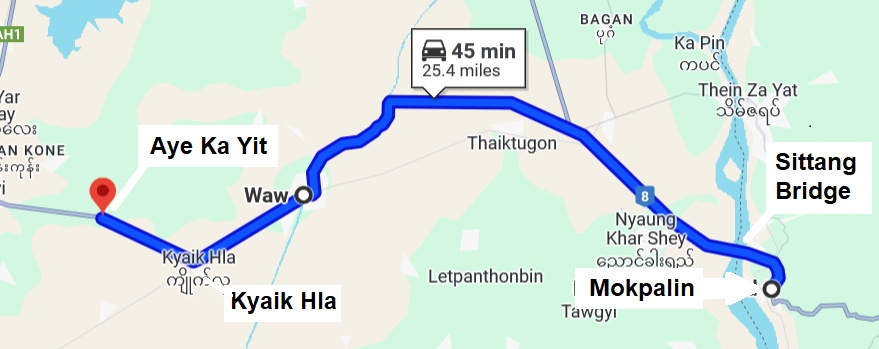
Mokpalin to Aye Ka Yit - approx. 25 miles.
33
All through this journey, every vehicle had its headlights blazing forth, and
Vehicles To the Mile.
V.T.M.
was never observed. For a night bomber, there could not possibly have been a more choice target. We pushed on and arrived in “E “ feeling dog tired, had a quick meal, and went to bed.
The following morning, we went back about two miles, to a place called "
Possibly Kyaik Hla?
K
“ and I established my reinforcement camp there.
All day we worked like hell, and by the evening we had dealt with roughly “eleven hundred” men. Mostly stragglers coming back from “Sittang” and hardly a man possessed a stitch to his back.
That night,
Private.
Pte
Parker from the
and one of my staff awakened me, as there was a loud noise of planes. It came nearer and nearer but very slow, and we could not make out what on earth it was.
"At last," I shouted out with great joy, “Tanks” and I was right, as at that moment twenty of them passed along the road about four hundred
...missing word... in front of us.
For days back it had been reported that tanks were coming into ‘Burma,’ and everyone had waited patiently for this valuable addition to our
...missing script... and it was a most reassuring sight.
They were supposed to be on their way to “Sittang,” but we learned later that they only went as far as “Waw” not being able to cross over a small bridge over a river.
In the early hours of
we heard the “Sittang bridge” being blown up, and from then on, at all hours up to the following night, stragglers were crawling in.
34
We received a few “Dogra” and Gurkha reinforcements. The Gurkhas, accompanied by two officers and the “Dogras” by “Shaw” who had just arrived from Rangoon, and by “Jeffries” who had been into Rangoon, collected the vehicles and returned.
Shaw had a heavy load of “Whisky,” Beer and Cigarettes, and we gave out a small ration to as many of the men as we could.
All this time my one and only cook had been working steadily boiling Rice, which was there in plenty and 'Dahl’ which we had with us. All Indian troops eat this meal, and all were satisfied. My cook did an exceptionally fine job. British troops cooked their own food.
Relocating to Pegu - 24 February 1942.
It was roughly 0330 hrs when I was awakened after a very short sleep, by the words, “Where the bloody hell is Smith?” This was the D.A.G. who had come to give me further movement orders. I had to proceed at once to “Pegu” and set up my camp there.
I gave orders to all the lads, and put them in charge of the offices about who I have already spoken. I then moved off with my own staff. Travelling was extremely slow, as there were literally hundreds of vehicles in convoy, once again nose to tail, and headlights blazing.
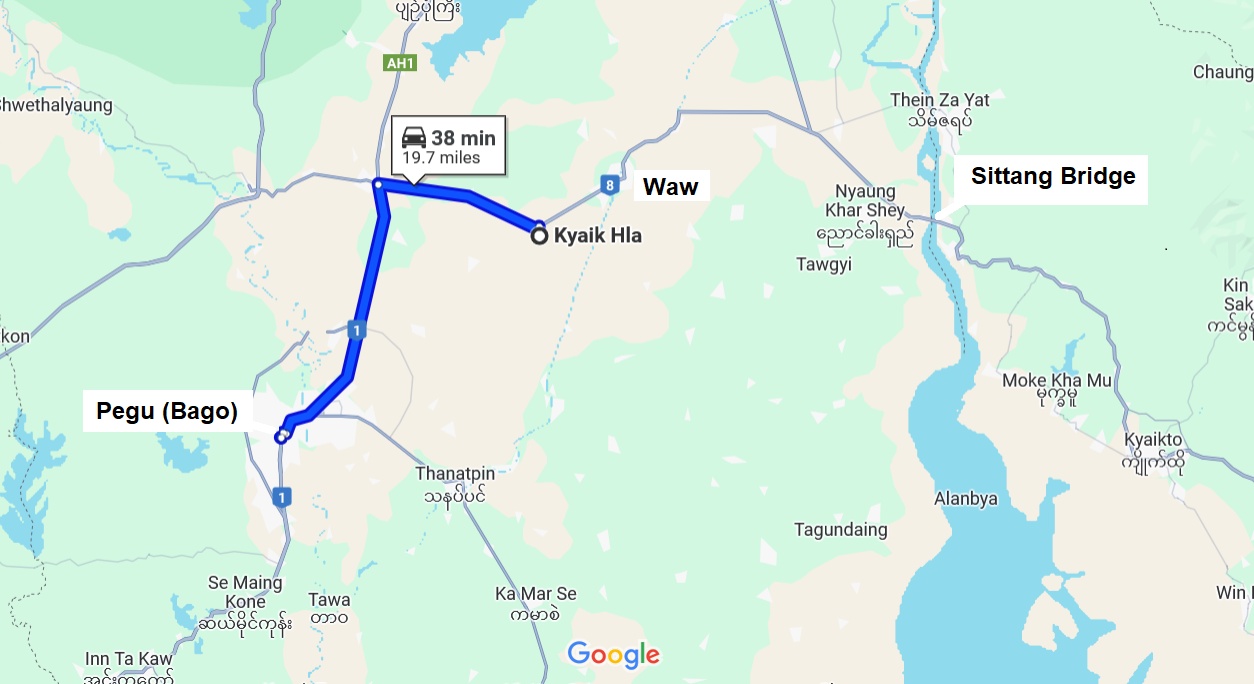
Kyaik Hla to Pegu.
35
Dawn had broken by the time we reached ‘Pegu’ which meant no sleep for me. I established my camp in the ‘
’ north east of the town and for the first time in weeks I had a roof over my head. Stragglers came rolling in all day and we were never idle.
It was while in ‘Pegu’ I became very friendly with the D.A.D.O.S. Major Williams and I was able to work with him very well. He had a large store in ‘Pegu’ and it was very easy for me when I wished any equipment etc. as I had been given permission to go into the store whenever I pleased, and help myself to whatever I wanted.
It was in this store, I tried to find a ‘Gurkha’ hat but unfortunately none would fit my large head. By this time we had learned, hats similar to, or the same as Gurkha hats, were the best possible head-gear for a country such as ‘Burma.’
It was while in ‘Pegu’ and after the Sittang Bridge show, and
that the remains of the Division were reforming, and all kinds of reports were coming in. I heard most of these reports, as nearly everyone was firstly sent to my camp to refit etc. etc. and then sent back immediately to their respective Bn.s.
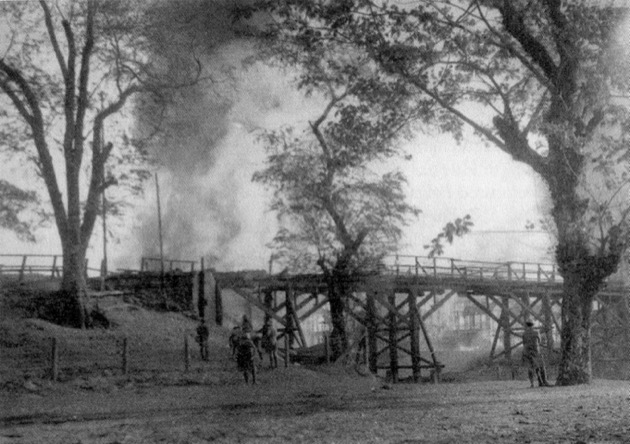
Waw on fire. Circa. 25 February 1942 the deserted village was burned to defend a wooden bridge. ref.
click here
36
5/17th Dogras - circa. 25 February 1942.
It was not until after a few days that I saw Major Terry, our own second in command, then commanding the Bn and he told me what our Bn had been through since I left at “Bilin.” He, Capt. Frank Parker and Ram Singh, apart from myself, were the only three officers from our Bn to cross the river. Petherbridge also came across the river, but he was still with Bde. H.Q. and came back with the “Brig. Ekin.”
Our Bn after reforming in “Kyaikto” had to take part in the fighting withdrawal from there to “Sittang,” and like everyone else, had a hard time.
Jock Ferrier, I was told, on two occasions made an extremely brilliant show, by knocking out an enemy mortar each time. Allan Bird our Adjutant was injured very badly, and was reported by some of our sepoys to have died soon after.
Tommy Thompson went into an attack, and did not return. He was reported as missing.
Frank Parker received a Bayonet wound in the lower part of the tummy, and how he managed to come across the river was a miracle. He was by now in Mandalay hospital.
The Col. Jock Ferrier and Buisra all reached the other bank of the river, but unfortunately were unable to make the crossing, and were captured. At least, they were all reported as missing. The colonel was reported to have been seen, being marched off by the Japs, and this, is our sincere hope, as there was never in every way, a better C.O.
Our Bn Doctor was last seen dressing some wounded, and it was assumed he also, was taken prisoner.
37
Jimmy Mortimer, who left the Bn a few days before myself at Bilin was now in Mandalay hospital with a bad knee, due to a fall.
The whole division suffered rather a hard knock, as a result of which, the Japs were able to cross the river in double time, and continue their advance through ‘Burma’ without much delay. In fact, the river formed no great obstacle to them, and to our troops it was a severe obstacle.
Everyone knew it would turn out to be a nasty corner ...unclear word... , but not quite so nasty as it turned out.
Our Bde. (48th) and Divisional H.Q. were able to cross the river by the bridge but the remainder of the Div. had to swim, owing to the fact, the bridge had been blown up much too soon.
The blowing of the bridge caused many different comments, but from all reports I received a few days after the incident, I formed my own opinion.
The order was given out that we would continue to hold the bridge-head, until all our forces were all across. This was all very well, but in actual fact, there was such a mix up going that at most times no one quite knew who held the bridge-head. It was ...missing script... in possession of it, when the bridge was blown.
At one time when the Japs were reported to be in possession of the bridge-head, the artillery received orders to open up on what was known to us as “Pagoda Hill” just at the other end of the bridge. They opened up with naval guns, and reports later received from the ‘Baloch’ proved their shooting was extremely accurate. The Baloch, not the Japs were there, and as a result suffered heavily.
38
Relocating to Hlegu - circa. 26 February 1942.
We had only been in Pegu for a couple of days, when the Japs had cut the main road from ‘Pegu’ to ‘Mandalay.’ “The Burma Road,” and Divisional H.Q. moved back a further thirty odd miles, to ‘Hlegu.’
Our Bn, or should I say “The remainder of our Bn.” moved with Div. H.Q. and formed their defence. I should like to say that most of our boys had either been killed, wounded or taken prisoner.
In “Hlegu” I once again formed my camp, and my work started immediately. I was only in “Hlegu” for two days, when I turned ill, about which I shall say something later on.
Back in “Pegu” the 48th Bde. along with a Bn of Cameronians who had newly arrived, and the tanks, were left to fight the rearguard action. Just like my “C” Company at “Bilin” their own withdrawal was cut off, and the had to fight their own way out.
It was in this action that the Lt. Col. White
Officer Commanding.
O.C.
1/7 Gurkhas, our extremely able C.O. lost his life, by a bullet from an enemy sniper.
Capt. “Woodhouse” our old 46th Bde Staff Captain was now with 48th Bde. and he was also killed by an enemy sniper. He was also a very fine and able person.
In “Hlegu” Shaw, “Jefferies” and Petherbridge were with the Bn making the officers strength up to four.
Ram Singh, although he had somehow come across the Sittang somehow or other went up to “Mandalay” or “Meiktila” from “Pegu” and no one knew just why.
39
I learned a few weeks later in “Maymyo” that he’d been given an order by someone to go up to “Meiktila,” collect the reinforcements there, and bring them down to the Bn which I understand he did.
One night in “Hlegu” we watched a terrific glow in the air. This was “
“ the oil refineries being raised to the ground. It was roughly 37 miles from Hlegu and just south west of “Rangoon.”
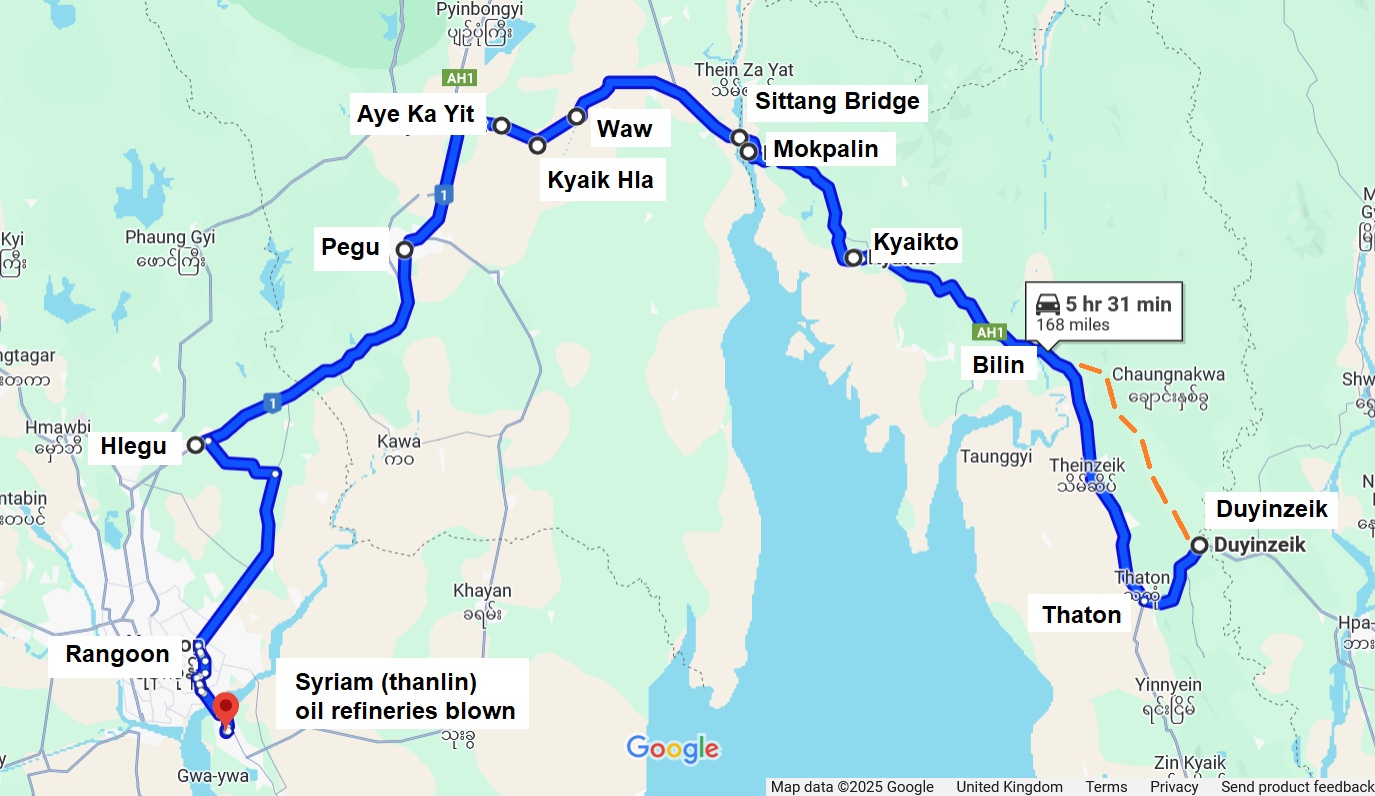
Duyinzeik to Hlegu.
Malaria.
For several days my own powers of endurance were slowly but surely dwindling, and one afternoon in “Hlegu” I went down with fever, and was doubled up with a severe pain in my tummy.
I was able to stick it out for a couple of days, but no longer, and in the end I was carried off on a stretcher to the nearest
Combat Casualty Station.
C.C.S.
From there I was immediately put on an Ambulance train and was in '
Prome (Pyay) military hospital.
Prome
’ hospital the same day.
40
We had no sooner arrived in “Prome” when we were told that the Japs had cut the road between there and Rangoon, which two days later was the means of the first famous “Road Block” “
“
In ‘Prome’ Hospital I was in a small room, along with my old friend the D.A.D.O.S. Major Williams, who was on his way to Maymyo for a tummy operation. He was not feeling too well. That night he was put onto a hospital ship at “Prome” and was soon on his way up the “Irrawaddy River,” to “Mandalay.” I followed him on another boat the next day.
Unfortunately our boat had only one engine in service, and we took fourteen days to reach “Mandalay.”
We had with us a Doctor Hart who only arrived in Rangoon the day before the Japs entered, and four Anglo-Burmese nurses who had been looking after the sick, all the way from “Moulmein.” This Staff worked like hell both night and day, and it was only due to their care that, I was so comfortable.
Every single day on that boat I had a fever with temperatures ranging from 102 to 105 and naturally I was gradually becoming weaker. My tummy by this time was in a frightful state, and I could not eat a thing.
A nurse was beside me at every minute they could spare, but I was so ill, I was completely unable to lift my head, owing to severe pain, and say a few sweet words to them.
We arrived in “Mandalay” early in the morning of March 17th, and the following morning we boarded the train for the hill station of “Maymyo” roughly 52 miles north west of “Mandalay.”
41
I was exceptionally disappointed with “Mandalay” not being particularly struck with anything there. In fact “Mandalay” was nothing but dirty wooden buildings right in the middle of the stinking heat of the plains.
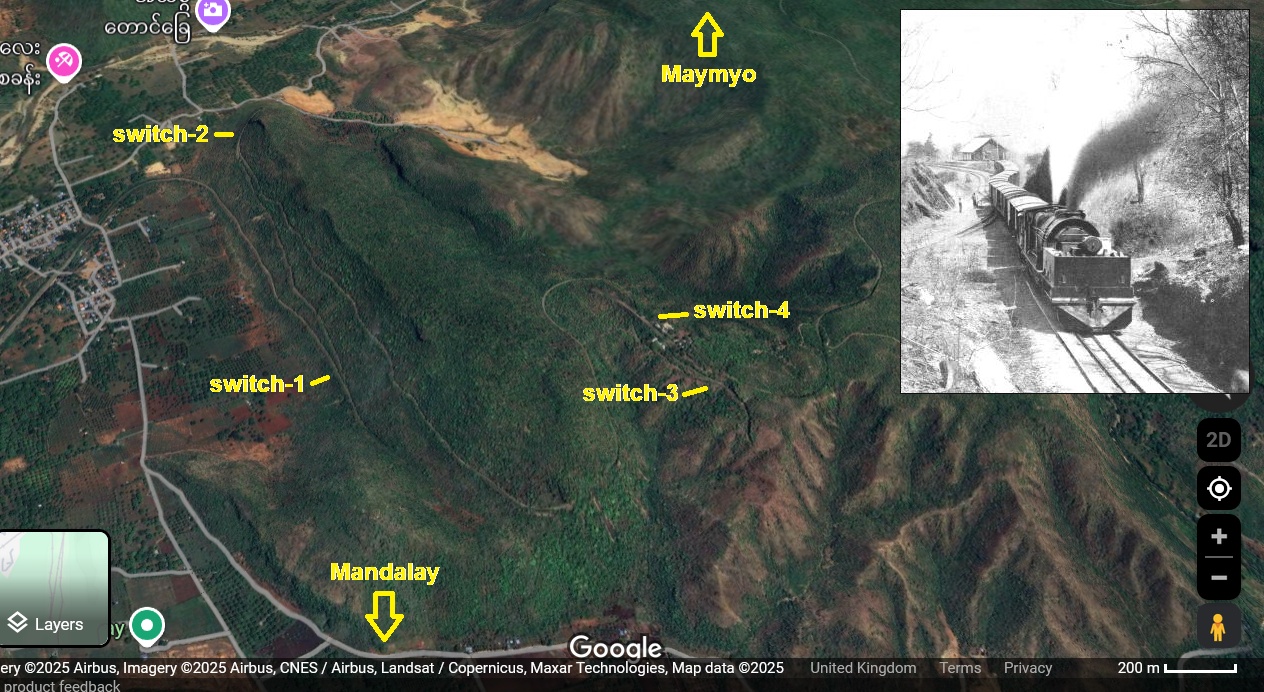
Switchback railway Mandalay to Maymyo. Inset:- "Beyer-Garratt" articulated locomotive working the Lashio Maymyo switchback since 1924. ref.
click here ref.
click here
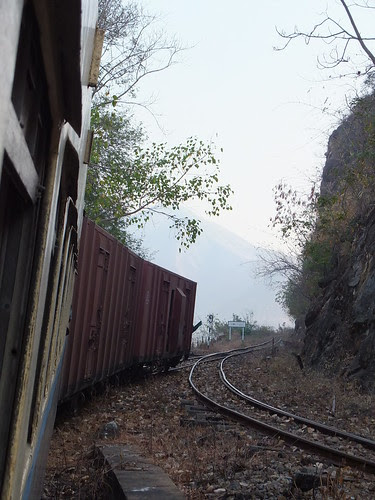
Switchback railway Mandalay to Maymyo.
Going up to “Maymyo” was very interesting and at the same time extremely pleasant. To go up one part of the hill, the train had three times to go up one part forwards, and for the next part of the incline it had to back up.
It was the first time I had ever seen this happen While going up here, I had my first look at Chinese troops, who had for days been pouring into ‘Burma’ in the thousands.
On the night of March 18th about ten o’clock we arrived in “Maymyo” and were soon in a comfortable bed in hospital, beneath beautiful white sheets. It was really heaven, as it was the first time for weeks on end. In fact, it was so comfortable that I was unable to close an eye, in spite of the fact I was by then feeling slightly better.
42
The Indian Army Lists - F. G. Smith ranks and appointments.
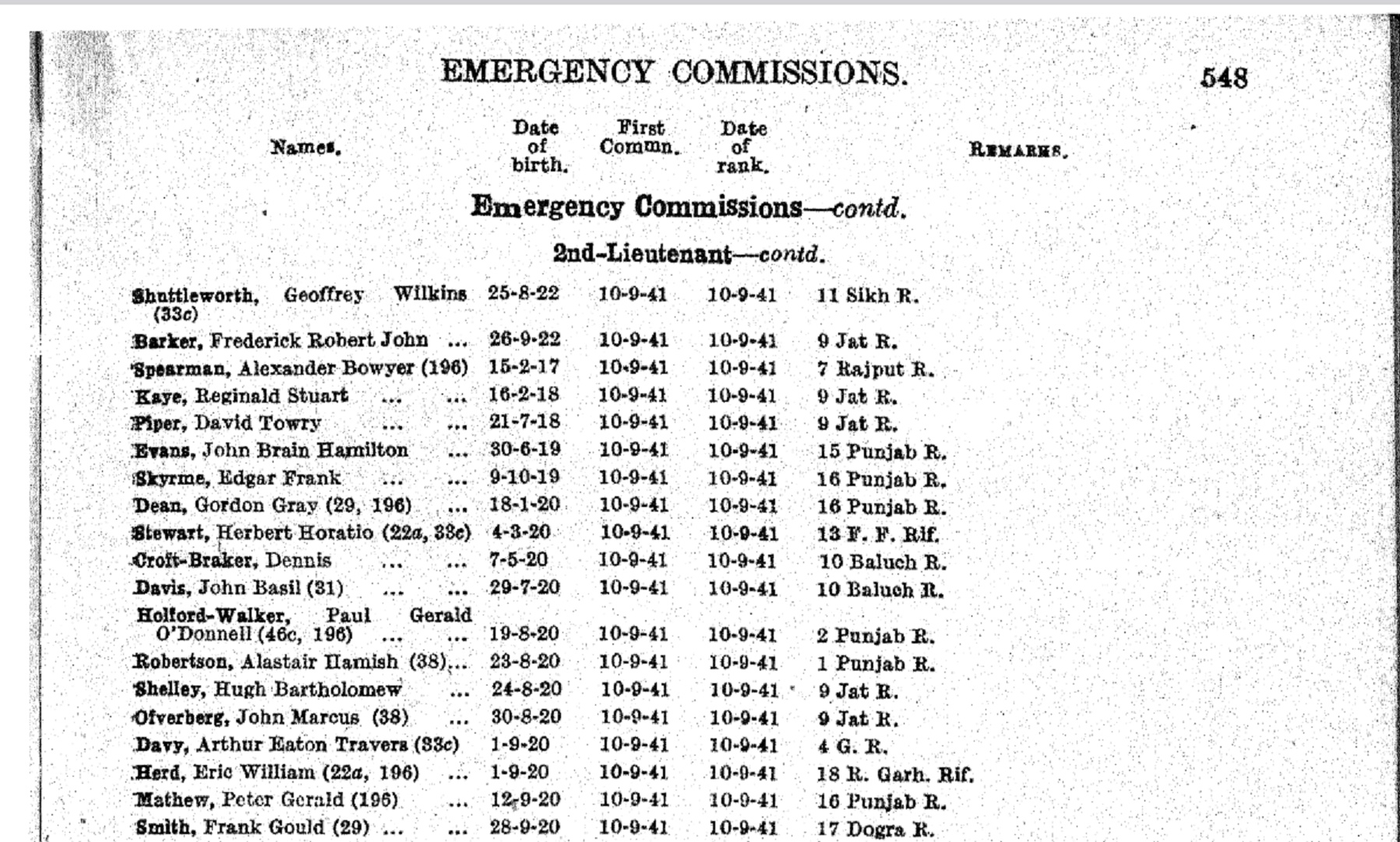
10 September 1941 - 2nd Lieutenant.
Epaulette: 1 pip.
43

F. G. Smith appointed to the rank of Lieutenant on 15 August 1942.
"W.S." stands for "War Substantive." Rank held only for the duration of war.
Epaulette: 2 pips.
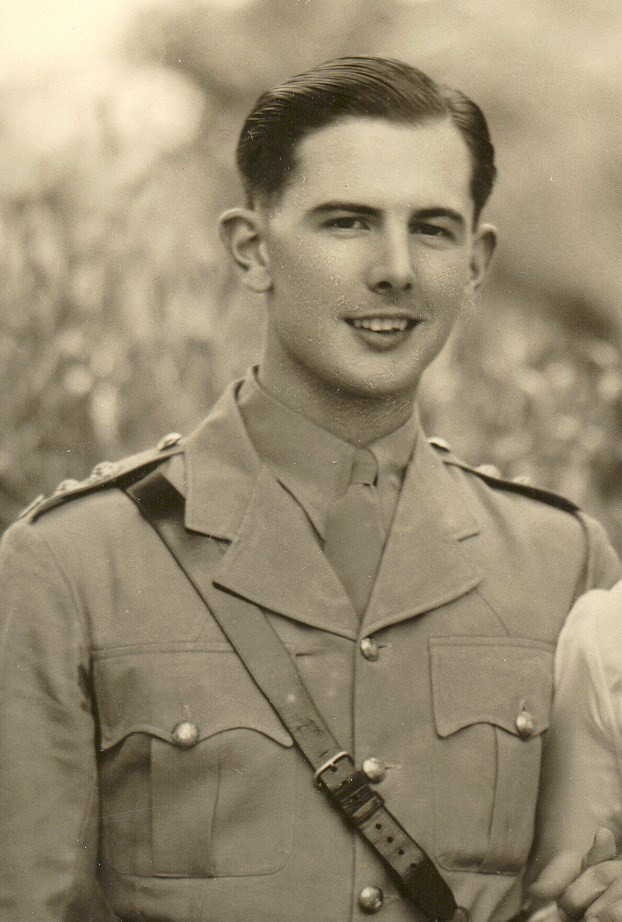
F. G. Smith appointed to the rank of Lieutenant on 15 August 1942. - ref.
click here
44
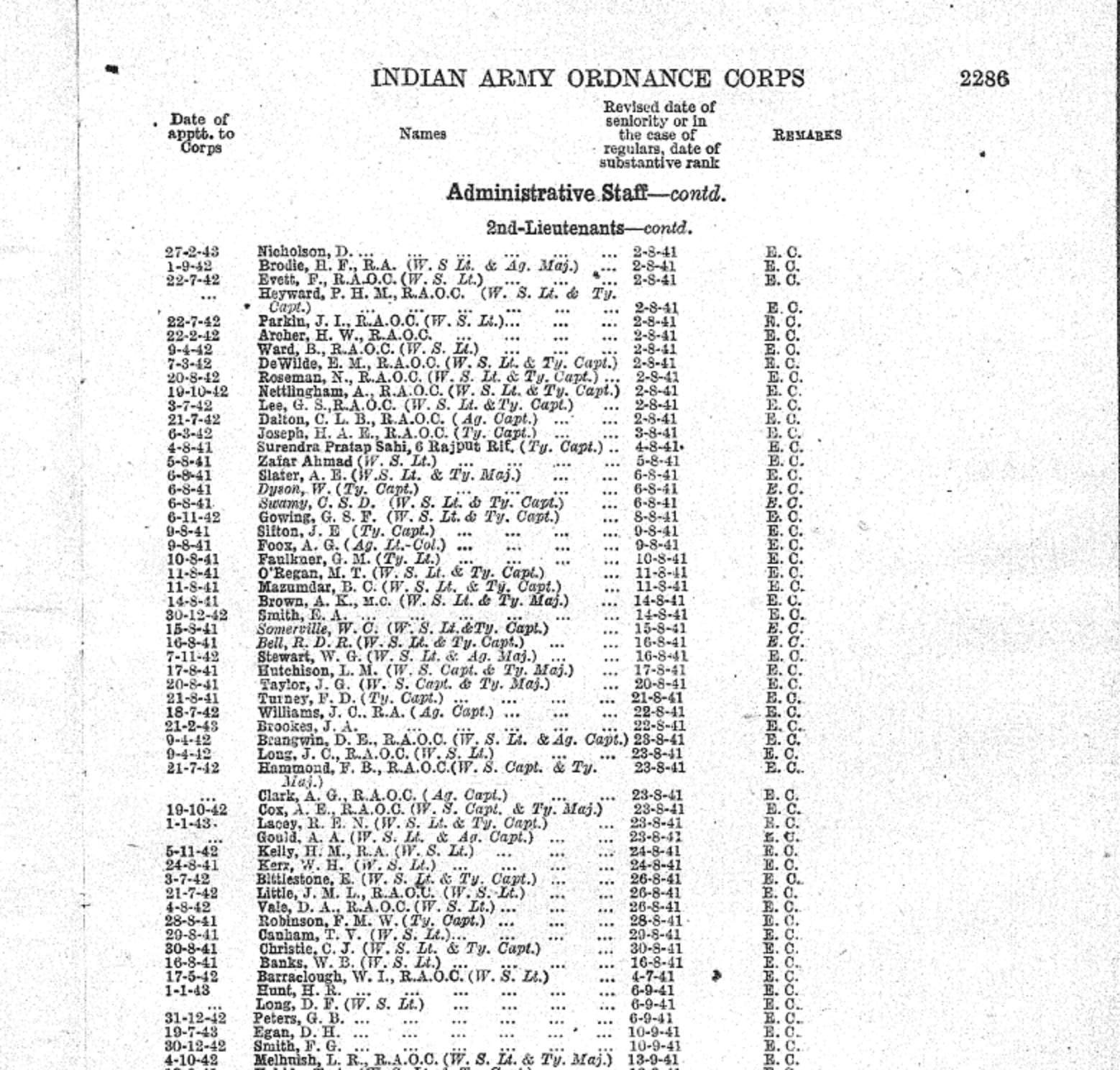
30 December 1942 - Appointed to the Indian Army Ordinance Corps.
45

F. G. Smith appointed to the rank of Captain on 30 December 1942.
"W.S." stands for "War Substantive." Rank held only for the duration of war.
"Ty." stands for "Temporary."
Epaulette: 3 pips.
